Off Duty Management

In order to efficiently respond to
requests and manage the employment of off-duty police officers, The Kearney Police
Department has partnered with Off Duty Management to provide services related
to hiring off-duty officers effective September 27,2021.
You may request to
hire off-duty police officers through the Off Duty Management web-based
service, OfficerTRAK®, or calling the number below.
Off Duty Management provides the following to the vendor:
- Online access to information through the OfficerTRAK® software including:
- Job-status
- Officer attendance
- Field notes and media files
- Post orders and instructions
- Past and future shift information
- Full liability coverage for the vendor, the agency, and the officer
- 24/7 vendor service
- Dedicated point of contact for scheduling and invoicing
- Officer payroll
Prohibited Off-Duty Employment*:
- Private detective agencies
- Licensed liquor establishments
- Sell, manufacture, or transport alcoholic beverages
- Collection agencies
- Advertising agencies (use of uniform or office to endorse products or businesses);
- Process server
- Bail bond agency
- Repossessing property or evicting persons or entities from premises
- Assisting in case preparation or investigation for any criminal defense or civil proceedings
- Employment as an investigator or in any capacity involving the use of police records for other than law enforcement purposes
- Employment that would be likely to bring the Police Department or the officer into disrespect, disfavor or ridicule, or involve the officer in a violation of Department policies, procedures or rules
- Other situations, locations or capacities not approved by the Chief of Police.
- Cannot access, use, or convey any data, files or information that is proprietary, is under the control of, or was collected and stored by this or any other law enforcement agency.
- Cannot perform any task or job that would bring discredit or embarrassment to the Kearney Police Department.
*PLEASE
NOTE: the above
list is not an all-inclusive and questions regarding permitted activity should
be forwarded to Off Duty Management.
RATES:
2 Hours minimum per request.
|
Regular
|
$57.50 |
|
Supervisor*
|
$69.00
|
|
Holiday**
|
$69.00 |
|
Emergency***
|
$63.25 |
| Vehicle |
$28.75/HR. $115 Daily M |
| State Sales
Tax 7% for all Security Posts/ No Tax for Traffic Jobs |
*Supervisor Rates: A supervisor is required when four or more
officers are requested.
**Holiday Rates: Rate will apply to the following days: New
Year’s Day, MLK Day, Presidents’ Day, Memorial Day, Juneteenth, Independence
Day, Labor Day, Thanksgiving Day, Day After Thanksgiving, Christmas Eve,
Christmas Day.
***Emergency
Rates: If request is received less than
72 hours prior to assignment the emergency pay rate goes into effect.
Cancellation policy:
Once an assignment has been approved and scheduled; vendors
canceling or reducing assignments are required to pay the full ODM
administrative fees for the first 24 hours of the original assignment. Vendors
canceling or reducing assignments within 48 hours of the start of the
assignment are required to pay the greater of officer hours worked or the
agency minimum hours plus ODM administrative fees for the first 24 hours of the
original assignment.
YOU CAN REQUEST SERVICE BY VISITING THE OFFICERTRAK® WEBSITE
OR CALL OFF DUTY MANAGEMENT 24/7 (308) 281-1827
Facilities General Information
The Buffalo County Facilities OMP department strives to provide extraordinary, professional and reliable building management services for all of the county facilities. Our Facilities Staff are trained professionals who are committed to providing a clean, safe, secure and functional building environment for both the county staff and the general public. Buffalo County Facilities OMP includes Operations (Custodial and Maintenance), Management (Facility Rental Use and Administrative Services), and Planning (Short term and long term improvements).
The 14 members of the Facilities OMP staff are responsible for maintaining all County Government buildings, including the Courthouse, Judicial Center, County Jail, Highway Department
buildings, Extension Building, 4 office buildings, and a recreation area with a lake and campground. There are over 30 buildings in total. In addition to these facilities, Facilities OMP maintains 11 parking lots, all walkways, steps and lawns adjacent to these areas, including landscaping, and provides snow and ice removal during the winter. The staff meet regularly to review work practices and safety regulations. They take part in additional training to keep up to date on the latest practices and procedures
relative to the cleaning, maintenance, security, and protection of County facilities, employees, and the general public.
"Facilities Operations" includes:
Custodial Services
Our Custodial Staff are trained cleaning professionals who are committed to providing a safe, clean and presentable building environment. We provide custodial services for 10 of our County buildings, their entrances, surrounding grounds, and parking areas. These buildings include:
--Buffalo County Courthouse
--Buffalo County Judicial Center
--Buffalo County Jail/EOC Center
--DHHS
--Adult Probation
--Juvenile Probation
--Extension Building
--215 Office Building
--Buffalo County Highway Department
--Buffalo County Weed District
Maintenance Services
Our Maintenance Staff are trained maintenance professionals who are committed to providing a safe, secure and functional building environment. Their work includes:
--Planned/Preventative Maintenance - includes inspections, servicing, general upkeep to buildings, equipment and grounds.
--Reactive/Unplanned Maintenance - repairing breakdowns of our facilities and grounds
--Overseeing underground fuel storage tanks/piping/lines and ensuring compliance with government regulations
--Monitoring/Maintaining Building Management Systems including HVAC controls, fire alarm systems, etc.
--Emergency Maintenance - assessing/repairing/coordinating repairs to critical system breakdowns
--Snow and Ice Removal
"Facilities Management" includes:
Facility Rental Use
The Facilities OMP department is responsible for facilitating the rental use of county facilities. At this time the principle location of this usage is the Buffalo County Extension Building. The responsibility includes:
--Schedule the usage of the Extension Building meeting rooms & kitchen, and maintain the master schedule
--Process all requests for usage of the meeting rooms & kitchen, and insure compliance with Board policies and regulations
--Execute rental contracts for outside group usage and collect rental fees associated with each agreement
--Verify appropriate requirements are met by groups using the facility
--Provide Facility Assistant when required, for groups with alcohol
--Provide proper access to scheduled groups
--Prep building for usage and follow up to ensure that it has been returned in proper condition
Administrative Services
Operations
--Ensure compliance with employment rules/regulations, county policies, and all applicable state and federal laws/regulations
--Oversee the daily operations of the Facilities OMP workforce and the work assignments
--Monitor, inspect and review the daily operations of the County facilities and grounds
--Manage installations, repairs, equipment testing and contracted maintenance by outside sources
--Oversee the development and implementation of operational policies and procedures
--Utilize and administer facility/building management software systems to manage the county facilities
--Coordinate professional development of Facilities OMP staff through training and workshops
--Have a representative on the County safety committee and any other committee as requested
Procurement
--Review and manage contracts related to county facilities
--Manage Facilities OMP equipment, materials and supplies and order inventory/supplies when needed
--Develop and maintain strong vendor and contractor partnerships to ensure the best quality, cost, and customer service for the County.
--Procure building equipment and supplies as needed for facilities
Claims/Accounts Payable
--Review and keep record of monthly bills and claims against Facilities OMP, including all utility bills for all County buildings
Budget
--Develop and manage Facilities OMP budgets, including preparing and maintaining a yearly budget
--Create cost estimates for anticipated individual projects.
--Manage budgeted costs on projects as they occur.
Management Software System - Facility Dude
--Facility management software utilized by the County
--Work tickets are generated by county employees needing custodial or maintenance assistance. All work requests need to be submitted on a work request utilizing Dude Solutions software (FacilityDude).
--Work tickets are assigned to Facilities staff and/or contractors for work orders
--Additional "preventative maintenance" work tickets are also generated with FacilityDude for scheduled servicing/inspecting/upkeep.
--Once the work has been completed, the work tickets are closed out and a follow up email is sent to the requestor to let them know that the work has been completed
--Data is collected from the information inputted into FacilityDude and utilized for managing current costs and projecting future expenses/budgeting
"Facilities Planning" includes:
Planning, Design & Development
--Develop and implement one, two and six year department plans
--Small Scale - Develop and implement small scale adjustments to
existing spaces to keep space up to date and adequate for current
usage needs.
--Large Scale - Coordinate design, engineering and construction of all Capital improvements including new buildings, new additions to existing buildings, and remodels of existing buildings.
--Ensure compliance with all applicable local, state and federals laws and regulations related to buildings and grounds
2020 Board of Commissioners Agendas/Minutes/Packets/Notices
Buffalo County furnishes the public information contained herein as a public service. This information may not reflect the most recent resolutions of the County Board and if the resolutions need to be legally relied upon, the most current version may be obtained at the office of the County Clerk. Please also read the disclaimer statement.
Open Meetings Act (effective July 19, 2012).
Zoning packets are available upon request from the Zoning Administrator.
Please choose the Agenda you wish to view from the list below.
| Date |
Notices |
Agendas |
Packets |
Minutes |
|
January 14, 2020
|
Notice |
Agenda
|
Packet |
Minutes |
|
January 28, 2020
|
Notice
|
Agenda |
Packet |
Minutes |
|
February 3, 2020
Zoning Administrator Interview
|
Notice
|
Agenda |
|
Minutes |
|
February 11, 2020
|
Notice
|
Agenda
|
Packet
|
Minutes
|
|
February 25, 2020
|
Notice
|
Agenda
|
Packet
|
Minutes
|
|
February 25, 2020
One & Six Year
Road Plan
|
Notice |
|
|
|
|
March 10, 2020
|
Notice
|
Agenda
|
Packet
|
Minutes
|
|
March 13, 2020 Emergency Meeting
|
Notice
|
Agenda
|
|
Minutes
|
|
March 18, 2020
Emergency Meeting
|
Notice |
Agenda |
|
Minutes |
|
March 24, 2020
|
Notice |
Agenda
|
Packet
|
Minutes
|
|
April 14, 2020
|
Notice
|
Agenda
|
Packet
|
Minutes
|
|
April 28, 2020
|
Notice
|
Agenda
|
Packet
|
Minutes
|
|
May 12, 2020
|
Notice
|
Agenda
|
Packet
|
Minutes
|
|
May 19, 2020
Emergency Meeting
|
Notice |
Agenda |
|
Minutes |
|
May 26, 2020
|
Notice
|
Agenda
|
Packet
|
Minutes
|
|
June 9, 2020
|
Notice
|
Agenda
|
Packet
|
Minutes
|
|
June 23, 2020
|
Notice
|
Agenda
|
Packet
|
Minutes
|
|
July 14, 2020
|
Notice
|
Agenda
|
Packet
|
Minutes
|
|
July 20, 2020
Board of Equalization
|
Notice |
Agenda |
|
Minutes |
|
July 21, 2020
Board of Equalization
|
Notice |
Agenda |
|
Minutes |
July 22, 2020
Board of Equalization
|
Notice
Notice (Form 425) |
Agenda |
|
Minutes |
|
July 28, 2020
|
Notice
|
Agenda
|
Packet
|
Minutes
|
|
August 11, 2020
|
Notice
|
Agenda
|
Packet
|
Minutes
|
|
August 25, 2020
|
Notice
|
Agenda
|
Packet
|
Minutes
|
|
August 25, 2020
Public Hearing
|
Notice |
|
|
|
|
September 8, 2020
|
Notice
|
Agenda
|
Packet
|
Minutes
|
|
September 8, 2020
Public Hearing
|
Notice |
|
|
|
|
September 22, 2020
|
Notice
|
Agenda
|
Packet
|
Minutes
|
|
October 13, 2020
|
Notice
|
Agenda
|
Packet
|
Minutes
|
|
October 27, 2020
|
Notice
|
Agenda
|
Packet
|
Minutes
|
|
November 10, 2020
|
Notice
|
Agenda
|
Packet
|
Minutes
|
|
November 24, 2020
|
Notice
|
Agenda
|
Packet
|
Minutes
|
|
December 8, 2020
|
Notice
|
Agenda
|
Packet |
Minutes
|
|
December 8, 2020 - Zoning
|
Zoning Packet |
Item 1 |
Item 2 |
Item 3 |
|
December 22, 2020
|
Notice
|
Agenda
|
Packet
|
Minutes
|
2019 Archive
2018 Archive
2017 Archive
2016 Archive
2015 Archive
2014 Archive
2013 Archive
2012 Archive
2011 Archive
2010 Archive
2019 Board of Commissioners Agendas/Minutes/Packets/Notices
Buffalo County furnishes the public information contained herein as a public service. This information may not reflect the most recent resolutions of the County Board and if the resolutions need to be legally relied upon, the most current version may be obtained at the office of the County Clerk. Please also read the disclaimer statement.
Open Meetings Act (effective July 19, 2012).
Zoning packets are available upon request from the Zoning Administrator.
Please choose the Agenda you wish to view from the list below.
Board Meeting Notices, Agendas, Packets, and Minutes
| Date |
Notice |
Agenda |
Packets |
Minutes |
| January 8, 2019 |
Notice |
Agenda |
|
Minutes |
January 22, 2019
|
Notice
|
Agenda
|
|
Minutes |
| February 12, 2019 |
Notice |
Agenda |
|
Minutes |
February 12, 2019
Road and Bridge Public Hearing |
Notice |
|
|
|
February 26, 2019
|
Notice |
Agenda |
|
Minutes |
| March 12, 2019 |
Notice |
Agenda |
|
Minutes |
March 13, 2019
Emergency Meeting |
Notice |
Agenda |
|
Minutes |
| March 26, 2019 |
Notice |
Agenda |
|
Minutes |
| April 9, 2019 |
Notice |
Agenda |
|
Minutes |
| April 23, 2019 |
Notice |
Agenda |
|
Minutes |
| May 14, 2019 |
Notice |
Agenda |
|
Minutes |
| May 28, 2019 |
Notice |
Agenda |
|
Minutes |
| June 11, 2019 |
Notice |
Agenda |
|
Minutes |
June 25, 2019
|
Notice |
Agenda |
|
Minutes |
July 9, 2019
|
Notice |
Agenda |
|
Minutes |
July 18, 2019
(Board of Equalization)
|
Notice |
Agenda |
|
Minutes |
July 19, 2019
(Board of Equalization)
|
Notice |
Agenda |
|
Minutes |
July 22, 2019
(Board of Equalization)
|
Notice |
Agenda |
|
Minutes |
| July 23, 2019 |
Notice |
Agenda |
|
Minutes |
July 23, 2019
(Board of Equalization)
|
Notice |
Agenda |
|
Minutes |
July 24, 2019
(Board of Equalization)
|
Notice |
Agenda |
|
Minutes |
| August 13, 2019 |
Notice |
Agenda |
|
Minutes |
| August 27, 2019 |
Notice |
Agenda |
|
Minutes |
| September 10, 2019 |
Notice |
Agenda |
|
Minutes |
| September 24, 2019 |
Notice |
Agenda |
|
Minutes |
| October 8, 2019 |
Notice |
Agenda |
|
Minutes |
| October 22, 2019 |
Notice |
Agenda |
|
Minutes |
| November 12, 2019 |
Notice |
Agenda |
|
Minutes |
| November 26, 2019 |
Notice |
Agenda |
|
Minutes |
| December 10, 2019 |
Notice |
Agenda |
|
Minutes |
December 19, 2019
Emergency Meeting |
Notice |
Agenda |
|
Minutes |
| December 23, 2019 |
Notice |
Agenda |
Packets |
Minutes |
2018 Archive
2017 Archive
2016 Archive
2015 Archive
2014 Archive
2013 Archive
2012 Archive
2011 Archive
2010 Archive
2018 Board of Commissioners Agendas/Minutes/Notices
Buffalo County furnishes the public information contained herein as a public service. This information may not reflect the most recent resolutions of the County Board and if the resolutions need to be legally relied upon, the most current version may be obtained at the office of the County Clerk. Please also read the disclaimer statement.
Open Meetings Act (effective July 19, 2012).
Zoning packets are available upon request from the Zoning Administrator.
Please choose the Agenda you wish to view from the list below.
Notice
Board Meeting Notices, Agendas, and Minutes
| Date |
Notice |
Agenda |
Minutes |
| January 9, 2018 |
Notice |
Agenda |
Minutes |
January 23, 2018
|
Notice
|
Agenda |
Minutes |
| February 13, 2018 |
Notice |
Agenda |
Minutes |
February 13, 2018
Road and Bridge Public Hearing |
Notice |
Agenda |
Minutes |
February 27, 2018
|
Notice |
Agenda |
Minutes |
| March 13, 2018 |
Notice |
Agenda |
Minutes |
| March 27, 2018 |
Notice |
Agenda |
Minutes |
| April 10, 2018 |
Notice |
Agenda |
Minutes |
| April 24, 2018 |
Notice |
Agenda |
Minutes |
| May 8, 2018 |
Notice |
Agenda |
Minutes |
| May 22, 2018 |
Notice |
Agenda |
Minutes |
May 22, 2018
(Board of Equalization) |
Notice
|
Agenda |
Minutes |
| June 12, 2018 |
Notice |
Agenda |
Minutes |
June 26, 2018
|
Notice |
Agenda |
Minutes |
July 10, 2018
|
Notice |
Agenda |
Minutes |
July 12,13 Zoning/GIS
Interviews |
Notice |
Agenda |
Minutes |
July 19, 2018
(Board of Equalization) |
Notice |
Agenda |
Minutes |
July 20, 2018
(Board of Equalization) |
Notice |
Agenda |
Minutes |
July 23, 2018
(Board of Equalization) |
Notice |
Agenda |
Minutes |
| July 24, 2018 |
Notice |
Agenda |
Minutes |
July 24, 2018
(Board of Equalization) |
Notice |
Agenda |
Minutes |
| August 14, 2018 |
Notice |
Agenda |
Minutes |
| August 28, 2018 |
Notice |
Agenda |
Minutes |
| September 11, 2018 |
Notice |
Agenda |
Minutes |
| September 25, 2018 |
Notice |
Agenda |
Minutes |
| October 9, 2018 |
Notice |
Agenda |
Minutes |
| October 23, 2018 |
Notice |
Agenda |
Minutes |
| November 13, 2018 |
Notice |
Agenda |
Minutes |
| November 27, 2018 |
Notice |
Agenda |
Minutes |
| December 3, 2018 |
Notice |
Agenda |
Minutes |
| December 11, 2018 |
Notice |
Agenda |
Minutes |
| December 11th Road Vacation Resolution |
2018-44 |
2018-48 |
|
| December 27, 2018 |
Notice |
Agenda |
Minutes |
2017 Archive
2016 Archive
2015 Archive
2014 Archive
2013 Archive
2012 Archive
2011 Archive
2010 Archive
Committee Appointments
2025 Committee Appointments
| Committee Name |
Committee Members |
|
Budget & Finance
|
Sherry Morrow - Chair
Dan Lynch
Bill D. Maendele
|
|
Facilities OMP
|
Sherry Morrow - Chair
Bill D. Maendele
Tim Higgins
|
|
Information Technology
|
Myron Kouba - Chair
Dan Lynch
Ivan Klein
|
|
Road & Bridge
|
Ivan Klein - Chair
Dan Lynch
Ron Loeffelholz
|
|
Noxious Weed District
|
Ron Loeffelholz - Chair
Ivan Klein
Myron Kouba
|
|
Human Resources/Insurance
|
Myron Kouba - Chair
Tim Higgins
Bill D. Maendele
|
|
Public Safety, Law Enforcement, & Emergency Management
|
Dan Lynch - Chair
Ron Loeffelholz
Sherry Morrow
|
|
Court & Judicial
|
Ivan Klein - Chair
Ron Loeffelholz
Sherry Morrow
|
|
Veterans Service
|
Myron Kouba - Chair
Bill D. Maendele
Ivan Klein
|
|
Zoning/Flood Plain
|
Ron Loeffelholz - Chair
Dan Lynch
Bill D. Maendele
|
|
Extension/Agricultural Society
|
Ron Loeffelholz - Chair
Myron Kouba
Tim Higgins
|
|
Election Commission
|
Tim Higgins - Chair
Bill D. Maendele
Dan Lynch
|
|
Legislative
|
Bill D. Maendele - Chair
Sherry Morrow
Tim Higgins
|
|
Ravenna Lake/Campgrounds Advisory
|
Myron Kouba - Chair
Ivan Klein
Tim Higgins
|
|
County Official Council
|
Tim Higgins - Chair
Sherry Morrow
Myron Kouba
|
| Law Enforcement Center Committee |
Sherry Morrow - Chair
Dan Lynch
Tim Higgins
|
2025 Agency Appointments
| Agency |
Appointee(s) |
|
Airport Zoning Board
|
Tim Higgins |
|
Buffalo County Economic Development Council
|
Sherry Morrow
Dan Lynch
|
|
Community Action Partnership of Mid-Nebraska Board
|
Myron Kouba |
|
Kearney Area Chamber of Commerce
|
Bill D. Maendele |
|
Kearney Area Visitors Bureau Advisory Board
|
Tim Higgins |
|
Mid-Nebraska Individual Services Advisory Board
|
Ivan Klein |
|
Region III Governing Board
|
Bill D. Maendele |
|
Solid Waste Agency
|
Ron Loeffelholz |
|
South Central Economic Development Council
|
Bill D. Maendele |
|
South Central Nebraska Area Agency On Aging Governing Board
|
Ivan Klein |
|
Two River Public Health Department
|
Daniel Lynch |
2025 State Agency Appointments
| Agency |
Appointee(s) |
|
Nebraska Jail Standards Board
|
Sherry Morrow |
|
Wireless Enhanced 911 Advisory Board
|
Tim Higgins |
|
Talk of the Town
|
Myron Kouba
Sherry Morrow
|
|
Community Connection
|
Tim Higgins |
2017 Board of Commissioners Agendas/Minutes/Notices
Buffalo County furnishes the public information contained herein as a public service. This information may not reflect the most recent resolutions of the County Board and if the resolutions need to be legally relied upon, the most current version may be obtained at the office of the County Clerk. Please also read the disclaimer statement.
Open Meetings Act (effective July 19, 2012).
Zoning packets are available upon request from the Zoning Administrator.
Please choose the Agenda you wish to view from the list below.
Notice
Board Meeting Notices, Agendas, and Minutes
| Date |
Notice |
Agenda |
Minutes |
| January 10, 2017 |
Notice |
Agenda |
Minutes |
January 19, 2017
Emergency Meeting |
Notice
|
Agenda |
Minutes |
| January 24, 2017 |
Notice |
Agenda |
Minutes |
| February 14, 2017 |
Notice |
Agenda |
Minutes |
February 24, 2017
(County Assessor Interviews) |
Notice |
Agenda |
Minutes |
| February 28, 2017 |
Notice |
Agenda |
Minutes |
| March 14, 2017 |
Notice |
Agenda |
Minutes |
| March 28, 2017 |
Notice |
Agenda |
Minutes |
| April 11, 2017 |
Notice |
Agenda |
Minutes |
| April 25, 2017 |
Notice |
Agenda |
Minutes |
| May 9, 2017 |
Notice |
Agenda |
Minutes |
| May 23, 2017 |
Notice |
Agenda |
Minutes |
| June 13, 2017 |
Notice |
Agenda |
Minutes |
June 27, 2017
|
Notice |
Agenda |
Minutes |
July 11, 2017
|
Notice |
Agenda |
Minutes |
July 11, 2017
(Board of Equalization) |
Notice |
Agenda |
Minutes |
July 18, 2017
(Board of Equalization) |
Notice |
Agenda |
Minutes |
July 21, 2017
(Board of Equalization) |
Notice |
Agenda |
Minutes |
July 24, 2017
(Board of Equalization) |
Notice |
Agenda |
Minutes |
| July 25, 2017 |
Notice |
Agenda |
Minutes |
July 25, 2017
(Board of Equalization) |
Notice |
Agenda |
Minutes |
| August 8, 2017 |
Notice |
Agenda |
Minutes |
| August 22, 2017 |
Notice |
Agenda |
Minutes |
| September 12, 2017 |
Notice |
Agenda |
Minutes |
| September 25, 2017 |
Notice |
Agenda |
Minutes |
| September 26, 2017 |
Notice |
Agenda |
Minutes |
| October 10, 2017 |
Notice |
Agenda |
Minutes |
| October 24, 2017 |
Notice |
Agenda |
Minutes |
| November 14, 2017 |
Notice |
Agenda |
Minutes |
| November 28, 2017 |
Notice |
Agenda |
Minutes |
| December 12, 2017 |
Notice |
Agenda |
Minutes |
| December 26, 2017 |
Notice |
Agenda |
Minutes |
2016 Archive
2015 Archive
2014 Archive
2013 Archive
2012 Archive
2011 Archive
2010 Archive
NOAA Weather-Ready Nation Ambassador
Buffalo County Emergency Management is now a NOAA Weather-Ready Nation Ambassador.
The Weather-Ready Nation Ambassador initiative is an effort to formally recognize NOAA partners who are improving the nation’s readiness against extreme weather, water, and climate events. As a Weather-Ready Nation Ambassador, your organization is committing to work with NOAA and other Ambassadors to strengthen national resilience against extreme weather.
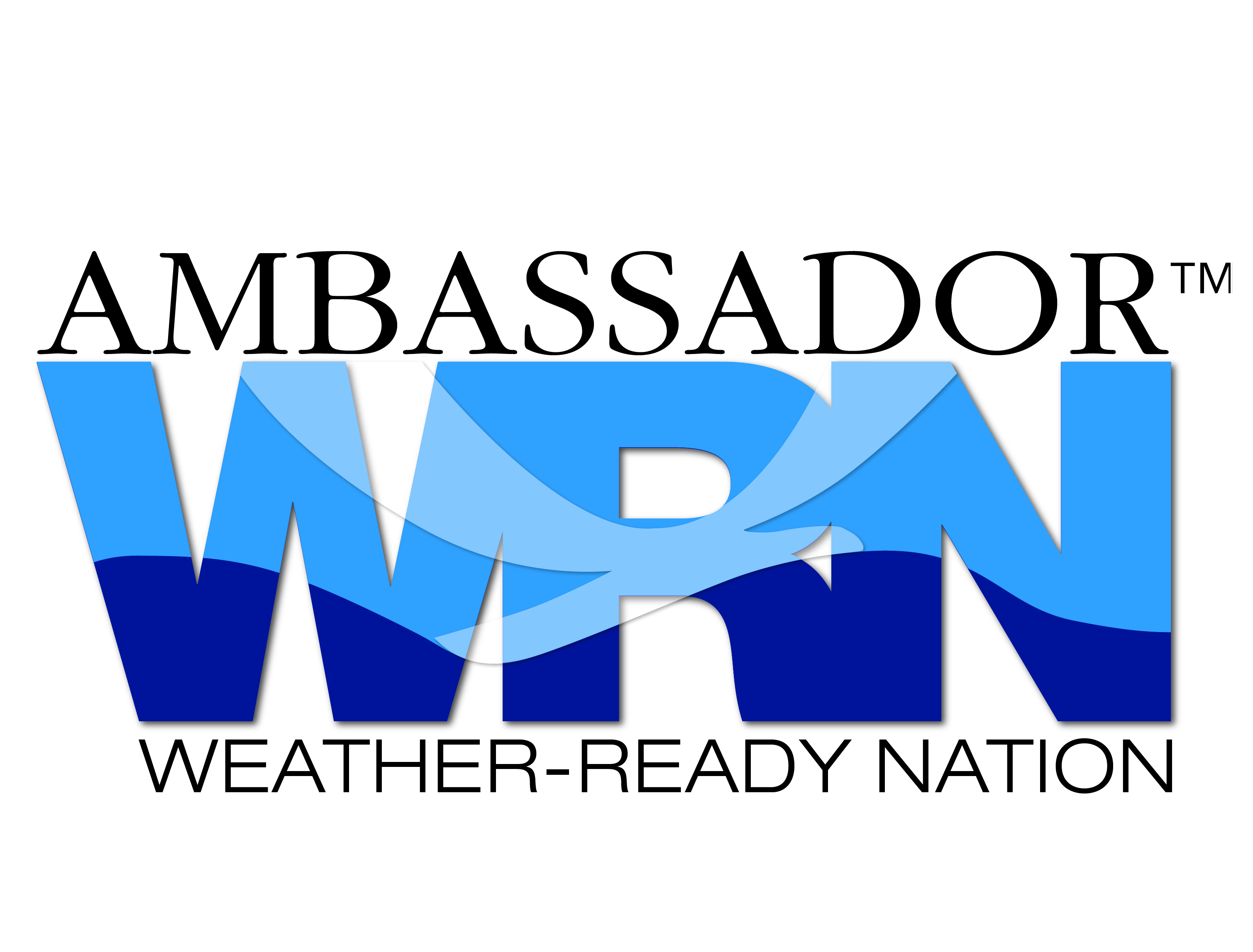 NOAA Weather-Ready Nation NOAA Weather-Ready Nation
Potential Shelter Locations
Emergency Manager
 View on map View on map
"PREPARE FOR THE WORST, HOPE FOR THE BEST"
Mission Statement: To provide a prepared and capable emergency management program for Buffalo County through training, community education and preparedness by providing information and education to the general public, area emergency responders and volunteers.
Values Statement: Emergency Management is by function and by law a cooperative effort on the part of all levels of government and the private sector. At the local level, Emergency Management is concerned with the protection and education of the public from the hazards and risks that affect them. The credibility of the program resides in the credibility of the program advocate. The Emergency Manager should exemplify the utility of the emergency management program. law a cooperative effort on the part of all levels of government and the private sector. At the local level, Emergency Management is concerned with the protection and education of the public from the hazards and risks that affect them. The credibility of the program resides in the credibility of the program advocate. The Emergency Manager should exemplify the utility of the emergency management program.
The job of the Emergency manager is defined by law. It does however, have a moral basis. The emergency manager must balance the duties authorized and required by law with the moral obligation of the public employee to do everything possible to protect and preserve the safety of citizens in the city and county.
Emergency Management expresses a strong commitment to provide interagency cooperation and coordination of activities relating to mitigation of, prevention of, preparedness for, response to, and recovery from disasters and emergencies.
The Emergency Manager's office is located in the Law Enforcement Center, 2025 Avenue A in Kearney, Buffalo County, Nebraska.
See the video below about things you can do at BeReadyNebraska.com!
The Desktop Buffalo Alert Application Is No Longer Supported
As of May 1st, 2014, Buffalo County Emergency Management will no longer support the Desktop Buffalo Alert Application. For continued weather alerts and emergency information please SIGN UP for our NEW ‘Cell Phone” and “E-mail” alerts at BuffaloWatch.net. Follow us on Facebook "Emergency Management Buffalo County/City of Kearney" and on Twitter @BuffaloCoNeEM. We apologize for any inconvenience the discontinuation of this desktop alert app may cause.
Juvenile Justice System Guide
“The only real mistake is the one from which we learn nothing.”
--John Powell
REASONS FOR BEING IN COURT
Delinquent: charged with breaking a law of a State or City Ordinance.
Status Offender: Charged with being beyond control of his/her parent(s) or habitually truant. Examples include not going to school, not keeping a curfew, running away from home, not obeying parent rules, and using drugs, alcohol or tobacco under age.
WHAT THE COURT MAY DO
Delinquent: May be placed on probation under the supervision of a Probation Officer at home or in a group home or other restricted program. The Court may alternatively place a delinquent in the custody of the State Office of Juvenile Services (OJS) / Health and Human Services (HHS) where he/she may be supervised at home, in another placement in the community (such as foster care, group home, or residential treatment), or at the Youth Rehabilitation Treatment Center (YRTC) in Geneva or Kearney.
Commitment to Office of Juvenile Services / Health and Human Services (HHS): HHS provides Court-ordered services to youth including those of the Office of Juvenile Services, the Youth Rehabilitation Treatment Centers, and Out of Home Placement.
Status Offender: Special supervision may be required. Offender may be placed at home on Probation or made a State Ward through the Department of Health and Human Services for out-of-home placement or services in the home.
YOUR RIGHTS
You have a right to:
- Know what has been filed against you;
- An attorney (a Public Defender may be provided at no cost);
- Face and cross-examine witnesses;
- Present evidence in your own defense;
- Testify if you wish; however, you do not have to testify;
- Be advised by the Judge as to what the Court can do with you; and
- Appeal the Court’s decision to the Nebraska Court of Appeals or Nebraska Supreme Court.
ADVICE FOR COURTROOM BEHAVIOR
DO…
- Dress neatly and cleanly, as you would for an important meeting.
- Be 15 minutes early, so you are ready to attend the hearing on time.
- Speak loudly and clearly.
- Be honest and make eye contact when talking.
- Respond to Judge’s questions by saying, “Yes, Your Honor,” or “No, Your Honor.”
DO NOT…
- Curse, swear or lie;
- Get angry or roll your eyes;
- Walk out of the courtroom (you could be held in contempt;
- Speak or act rudely;
- Take a cell phone into the courtroom;
- Slouch or chew gum; or
- Wear sagging pants, offensive T-shirts or gang-related items.
DETENTION
Confinement in a locked facility for a period of time until your case is tried or a more suitable placement is found.
STAFF-INTENSIVE PLACEMENT
Unlocked staff-intensive placement for a period of time until your case is tried or a more suitable placement is found.
YOU MAY BE PLACED AT A DETENTION OR STAFF-SECURITY FACILITY IF YOU…
- ...fail to follow court orders (any law violation, including Court orders to obey your parents’ rules and curfew, and/or attend school).
- ...are a runaway youth (a history of running from home or if you run from your Court-ordered placement, such as foster or group home).
- …are a danger to yourself or others (violent, aggressive, gang-related behavior or use of alcohol or drugs).
- ...are being discharged unsatisfactorily from a placement facility. If you are not following rules of your Court-ordered placement and are discharged, you may be detained.
- ...an OJS evaluation is ordered to be done residentially.

An evaluation can be ordered by the judge to be completed while you are detained.
WHEN A YOUTH IN CHARGED WITH A CRIME:
| Step |
Description |
| 1. Arrest |
Upon arrest by Law Enforcement, the Officer may: 1) Street-
release, 2) Cite and release to a parent, or 3) Arrest and get authorization to detain.
|
| 2. Detention Decision |
If recommended by Law Enforcement, a Probation Officer assesses for detention or release to parent. If detained, the Deputy County Attorney reviews all information files the appropriate Petition and requests a hearing, which should be held in a timely manner. The Court reviews all facts and determines if further detention is needed. A Petition generally must be filed within 48 hours of detention, excluding weekends and holidays. If the youth is not detained, a report is forwarded to the County Attorney for a filing decision.
|
| 3. Filing |
A petition is filed in the court, or declined. The matter might be diverted without filing a Petition. The County Attorney may decide to charge the youth in Adult Court. If charged with a felony or misdemeanor, the youth could be detained.
|
| 4. Arraignment |
Prior to the hearing, the youth meets with his/her attorney to discuss charges and how to proceed. Through the attorney, a plea of admission, denial, or no contest is entered. If the youth denies the charge(s), the Court will schedule an Adjudication Hearing. If youth admits to the charge(s), the Court will schedule a Disposition Hearing and may order evaluations.
|
| 5. Adjudication |
This is the trial of the Petition, where the State must prove up on the charge(s). If Court finds the Petition to be true, Court acquires jurisdiction of the youth and the matter is then set for disposition. If the Petition is not found to be true, the case is dismissed.
|
| 6. Predisposition Investigation |
The Court may order a predisposition investigation (PDI) by a Probation Officer prior to the disposition hearing, which involves Collecting information from the youth, his/her family, the schools, previous mental health providers, and others. This is so the Judge can make an informed decision about how best to hold the offender accountable and address his or her specific needs. More evaluations may be required (such as chemical dependency or mental health). In abuse-neglect cases, the PDI and other evaluations are done by the Office of Juvenile Services (OJS).
|
| 7. Disposition Hearing |
Based on the PDI and other case information, the Court orders a plan to ensure accountability and rehabilitation. The plan could include out-of-home placement, further evaluation, treatment, probation, intensive supervision, or other services.
|
FREQUENTLY ASKED QUESTIONS
What is Juvenile Court?
Nebraska laws have separate guidelines for juveniles (as opposed to adults, age 18 and over) who have violated the law or have other behaviors in need of intervention. Juvenile Court involvement is not considered to be a criminal record, but is intended to provide the juvenile an opportunity for rehabilitation.
What is a petition?
A petition is a legal paper, filed in the Court, outlining why you are being brought to court.
How will I know when to go to court?
You will receive a summons or letter giving the date, time, and location. The number of times you attend depends on individual circumstances. Inform the Court and Probation Officer of address or telephone changes.
What if I miss a hearing?
The judge could order you to be picked up by law enforcement, detained, and brought before the Court to explain why you ignored the Court’s notice.
What if I do not follow the Court’s rules?
A motion to review or revoke your placement or probation may be filed by the County Attorney, asking the Court to place more severe requirements on your probation or place you in an institution or state juvenile correctional facility.
Can my record be sealed (kept confidential)?
You may ask the Court to seal your records. This sets aside the record and it cannot be opened without Court approval and good cause. However, even if sealed, certain persons or agencies may still be able to access your records.
What if I waive the right to an attorney?
If you do so, you would be representing yourself. If you do not have an understanding or knowledge of legal options and process (such as motions to make, how to call and examine witnesses, and how to request services from the Court), you may be adversely affected. Remember, you can request an attorney to represent you at any point in the process.
| Office |
Phone Number |
| Attention Center |
(308) 236-1922 |
| County Attorney’s Office |
236-1222 |
| County Court |
236-1228 |
| City of Kearney Attorney’s Office |
237-3155 |
| Crisis Assistance Center |
(800) 325-1111 |
| Detention Center |
(308) 233-5281 |
| District Court |
236-1246 |
Health & Human Services (HHS)
• Geneva/Kearney
• Office of Juvenile Services (OJS)
• Out-of-home Placements
• Youth Rehabilitation and Treatment Centers
|
865-5592 |
| Juvenile Diversion |
236-1922 |
| Truancy/Juvenile Diversion |
236-1920 |
| State Probation |
236-1251 |
| Buffalo County Sheriff |
236-8555 |
Kearney Police Department
• non-emergency
• EMERGENCY
|
237-2104
911 |
| Family Resource Council |
237-4472 |
| Nebraska Workforce Development |
865-5404 |
Region III
• Early Intensive Care Coordination
• Professional Partner Program
|
237-5113
Ext. 238
Ext. 238 |
| Buffalo County Community Health Partners |
865-2284 |
Each individual is entitled to be, and is capable of being, responsible for his or her lawful participation in society.
Revised from the Crime Commission brochure “A Guide to Juvenile Court for Parents & Children.”
A printer-friendly version of this page is available.
Domestic Violence
Purpose:
This Division seeks protection for victims of violence in intimate relationships through aggressive and consistent prosecution of offenders.
The Buffalo County Attorney recognizes the importance of communicating and cooperating with law enforcement and other public and private community agencies that provide services to families, victims, and perpetrators of domestic violence. A specialized Domestic Violence Prosecution Unit, in coordination with other community agencies, provides the best opportunity to achieve the following goals:
- To stop the violence.
- To protect the victim from additional acts of violence committed by the Defendant.
- To protect the children or other family members from exposure to, or possible injury from, domestic violence.
- To provide restitution to the victims.
- To hold the offender accountable for their violent conduct.
Policy:
The State of Nebraska has a critical interest in reducing the number of incidents of domestic violence and increasing the number of positive results in domestic violence prosecutions.
It is the position of the Buffalo County Attorney that the aggressive prosecution of domestic violence is necessary to protect victims and future victims of domestic violence.
Resources and Information
IF YOU OR SOMEONE YOU KNOW NEEDS HELP, CALL:
NATIONAL DOMESTIC VIOLENCE HOTLINE
(800) 799-7233
NATIONAL SEXUAL ASSAULT HOTLINE
(800) 656-4673
NEBRASKA DOMESTIC VIOLENCE/SEXUAL ASSAULT HOTLINE
(800) 876-6238
LINEA DE CRISIS EN NEBRASKA (EN ESPANOL)
(877) 215-0167
DO NOT USE E-MAIL TO REPORT CASES OF ABUSE.
IF THERE IS AN EMERGENCY CALL LOCAL LAW ENFORCEMENT IMMEDIATELY.
|
|
The S.A.F.E. Center
(The Spouse/Sexual Abuse Family Education Center)
3710 Central Avenue, Suite 10
Kearney, NE 68847
(308) 237-2599
(877) 237-2513
http://www.safecenter.org
All Services are Free & Confidential
24-hour Crisis Line
Crisis Support
Emergency Shelter
Support Groups
Supportive Atmosphere
Liaison with Community Agencies
Public Education Presentations
Protection Order Advocacy
Information & Referrals for:
Counseling, Housing, Legal Alternatives,
Emergency Assistance and much more!
Follow-up contact
|
|
Breaking the Silence: Information for Victims of Intimate Violence
A Victim’s Guide to the Nebraska Criminal Justice System
VINE (Victim Information and Notification Everyday)
VINE is a free automated service that monitors the custody status of adult inmates in all county jails and state prisons. You can arrange to receive telephone and e-mail notification when an offender’s custody status changes. Updated information is available 24 hours a day. VINE is available in English and Spanish and supported by 24-hour operator assistance.
The Nebraska VINE service is provided by the Nebraska Sheriff’s Association, Nebraska Domestic Violence Sexual Assault Coalition, Nebraska Coalition for Victims of Crime, Nebraska County Attorneys’ Association, Nebraska Department of Correctional Services, Nebraska Crime Commission and CJIS Advisory Committee.
NEBRASKA VINE NUMBER: 877-NE 4 VINE or (877) 634-8463.
Register or Find an Offender Online at www.vinelink.com
A Summary of Nebraska’s Legal System
Other Resources
Nebraska Department of Health and Human Services
Nebraska Domestic Violence/Sexual Assault Coalition (NDVSAC) and Hotline
Brochure
(800) 876-6238
National Domestic Violence Hotline
(800) 799-SAFE (800-799-7233)
US Department of Justice
Violence Against Women Website
Minnesota Center Against Violence and Abuse
National Organization for Victim Assistance
800-TRY-NOVA (800-879-6682)
National Victim Center
800-FYI-CALL (800-394-2255)
National Center for the Prosecution of Violence Against Women
National Center for Victims of Crime
Wireless Emergency Alerts
To enhance public safety, a free Wireless Emergency Alerts service is rolling out. WEA (pronounced “wee”) messages are text-like alert messages received by your mobile device during an emergency in your area. The purpose of WEA is to provide an increasingly mobile American public with a free and fast way to receive critically important information.
Frequently Asked Questions:
Why is this important to me?
Alerts received at the right time can help keep you safe during an emergency. With WEA, alerts can be sent to your mobile device when you may be in harm’s way, without need to download an app or subscribe to a service.
What are WEA messages?
Wireless Emergency Alerts (WEA) are emergency messages sent by authorized government alerting authorities through your mobile carrier. Government partners include local and state public safety agencies, FEMA, the FCC, the Department of Homeland Security, and the National Weather Service.
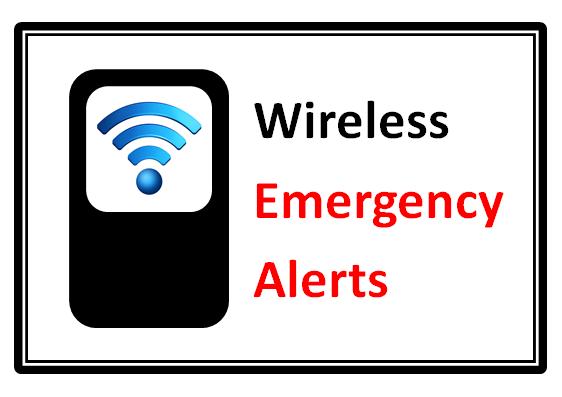
What types of alerts will I receive?
- Extreme weather, and other threatening emergencies in your area
- AMBER Alerts
- Presidential Alerts during a national emergency
What does a WEA message look like?
WEA will look like a text message. The WEA message will show the type and time of the alert, any action you should take, and the agency issuing the alert. The message will be no more than 90 characters.
How will I know the difference between WEA and a regular text message?
WEA messages include a special tone and vibration, both repeated twice.
What types of WEA messages will the National Weather Service send?
- Tsunami Warnings
- Tornado and Flash Flood Warnings
- Hurricane, Typhoon, Dust Storm and Extreme Wind Warnings
- Blizzard and Ice Storm Warnings
What should I do when I receive a WEA message?
Follow any action advised by the emergency message. Seek more details from local media or authorities.
Will I receive a WEA message if I’m visiting an area where I don’t live, or outside the area where my phone is registered?
Yes, if you have a WEA-capable phone and your wireless carrier participates in the program. For information about which mobile devices are WEA-capable and carrier participation, please visit http://www.ctia.org/wea or contact your wireless carrier.
What if I travel into a threat area after a WEA message is already sent?
If you travel into a threat area after an alert is first sent, your WEA-capable device will receive the message when you enter the area.
When will I start receiving WEA messages?
It depends. WEA use begins in the spring of 2012, but many mobile devices, especially older ones, are not WEA-capable. When you buy a new mobile device, it probably will be able to receive WEA messages. For information about which mobile devices are WEA-capable, please visit http://www.ctia.org/wea or contact your wireless carrier.
Is this the same service public safety agencies have asked the public to register for?
No, but they are complementary. Local agencies may have asked you to sign up to receive telephone calls, text messages, or emails. Those messages often include specific details about a critical event. WEA are very short messages designed to get your attention in an emergency situation. They may not give all the details you receive from other notification services.
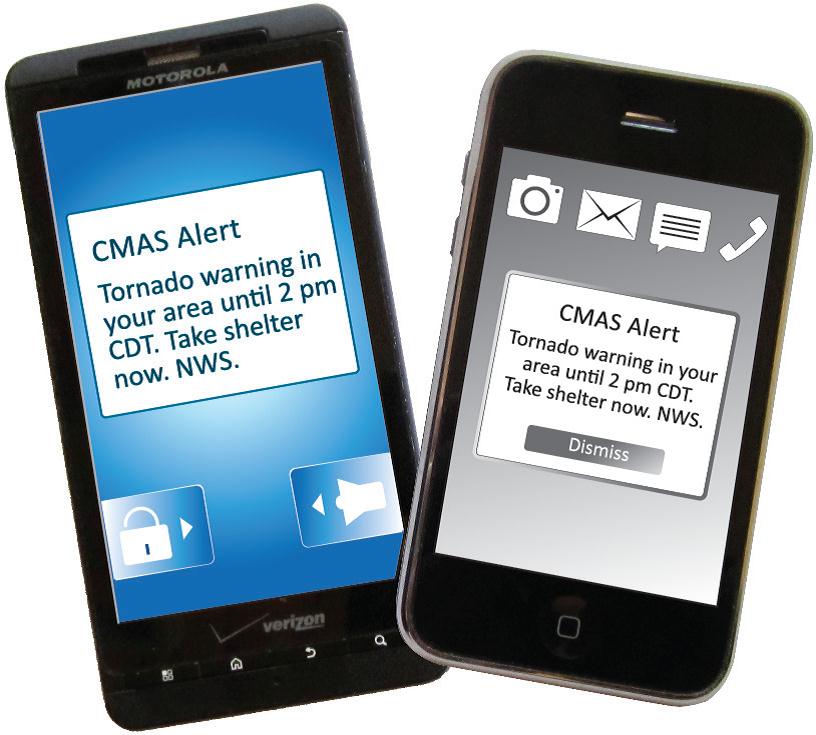
Will I be charged for receiving WEA messages?
No. This service is offered for free by wireless carriers. WEA messages will not count towards texting limits on your wireless plan.
Does WEA know where I am? Is it tracking me?
No. Just like emergency weather alerts you see on local TV, WEA are broadcast from area cell towers to mobile devices in the area. Every WEA-capable phone within range receives the message, just like every TV shows the emergency weather alert if it is turned on. TV stations, like WEA, don’t know exactly who is tuned in.
Will a WEA message interrupt my phone conversations?
No, the alert will be delayed until you finish your call.
How often will I receive WEA messages?
You may receive frequent WEA messages during an emergency. Message frequency depends on the number of imminent threats to life or property in your area.
If, during an emergency, I can’t make or receive calls or text messages due to network congestion, will I still be able to receive a WEA message?
Yes, WEA messages are not affected by network congestion.
What if I don’t want to receive WEA messages?
You can opt-out of receiving WEA messages for imminent threats and AMBER alerts, but not for Presidential messages. To opt out, please refer to instructions from your wireless carrier or visit http://www.ctia.org/wea for more information.
How will I receive alerts if I don’t have a WEA-capable device?
WEA is one of many ways you can receive emergency notifications. Other sources include NOAA Weather Radio, news media coverage, the Emergency Alert System on radio and TV broadcasts, social media, and other alerting methods offered by local and state public safety agencies. Your best use of WEA is to immediately seek additional information about the imminent threat impacting your area.
A flyer with more information about
Wireless Emergency Alerts is available.
Local Emergency Planning Committee
The Buffalo County Local Emergency Planning Committee (LEPC) is not active at this time.
The committee consists of representatives from the community. The membership includes law enforcement, emergency medical services, fire services, media, industry, and local officials.
The committee was organized under the Emergency Planning and Community Right-to-Know Act (EPCRA), also known as Title III of the Superfund Amendments and Reauthorization Act (SARA) passed by
emergency plan includes the following: an identification of local facilities and transportation routes where hazardous material are present; the procedures for immediate response in case of an accident; a plan for notifying the community that an incident has occurred; the names of response personnel at local facilities; and a plan for conducting exercises to test the plan.
What is Shelter-in-Place?
Shelter in Place "is an emergency response concept for the general public designed to reduce the chance of injury during a chemical accident. This to inform the public about the five steps of "sheltering inplace" during a chemical emergency. How to "Shelter in place where you are," according to emergency officials, "unless you areinstructed to evacuate." More about Shelter-in-Place
Safe Room Q & A
What is a safe room? What are the design requirements for a FEMA safe room?
A safe room is a hardened structure specifically designed to meet FEMA criteria and provide "near-absolute protection" in extreme weather events, including tornadoes and hurricanes. The level of protection provided by a safe room is a function of its design parameters, specifically the design wind speed and resulting wind pressure and the wind-borne debris load resistance. To be considered a FEMA safe room, the structure must be designed and constructed to the guidelines specified in FEMA P-320, Taking Shelter
from the Storm: Building a Safe Room for Your Home or Small Business (FEMA, third edition, 2008a) (for home and small business safe rooms). Additionally, all applicable Federal, State, and local codes must be followed. When questions arise pertaining to the differences between FEMA P320 criteria and another code or standard, the most conservative criteria should apply.
Should I have a safe room?
Pages 6 through 10 of FEMA P-320 (FEMA, 2008a) provide background information to help homeowners decide if a safe room is needed in their home. Homeowners and small-business owners should also refer to the Homeowner’s Worksheet, Assessing Your Risk (Table I-1) in FEMA P-320 (FEMA, 2008a); this is an easy-to-use matrix that helps users decide whether a safe room is a matter of preference, should be considered, or is the preferred method for protection from extreme winds.
My house has a basement. Do I need a safe room?
Some strong tornadoes have resulted in loss of floor framing, collapse of basement walls, and death and injuries to individuals taking refuge in a basement. What constitutes an acceptable level of protection is an individual decision. A basement may be the safest place to seek shelter for homes without a safe room, but it will not provide the same level of protection as a safe room unless it has been designed and constructed to provide the level of protection in accordance with FEMA P-320 (FEMA, 2008a) and FEMA P-361 (FEMA, 2008b).
A basement is a good location to install a shelter or build a safe room, but access for handicapped or physically challenged individuals may be limited. The flood risk of your location may also affect whether it is appropriate to place a safe room in your basement. If your house or neighborhood is prone to flooding, the basement may not be an appropriate location for taking refuge.
Where can I find information about obtaining FEMA funding to construct a safe room? Are there any funds available in my area?
For project eligibility and financial assistance questions, please contact your Local Emergency Manager. Your Emergency Manager can advise you on what information must be provided for your project to be considered for funding, as well as any applicable Federal, State, and local design requirements.
Can I still apply for FEMA funding after I have begun construction of a safe room or purchased a safe room?
No. You must apply for funding before the purchase of a safe room or beginning any construction. Section D.2, Part III of FY 2011 Hazard Mitigation Assistance Unified Guidance (FEMA, 2010) states that costs related to projects for which actual physical work (such as groundbreaking, demolition, or construction of a raised foundation) has occurred prior to award or final approval are ineligible.
What costs are eligible for funding under a safe room grant?
Allowable costs for safe room projects funded under FEMA’s Hazard Mitigation Grant Program (HMGP) are those components related to, and necessary for, providing life safety for building residents in the immediate vicinity during an extreme-wind event. The funding covers design and building costs related to structural and building envelope protection. The funding covers both retrofits to existing facilities and new construction projects, and applies to both single- and multi-use facilities.
Eligible costs are only those consistent with FEMA-approved performance criteria as provided in FEMA P-320 (FEMA, 2008a). These criteria are summarized in Table 6 (below) of the 2011 FY FEMA Hazard Mitigation Assistance Unified Guidance (FEMA, 2010). (Click the table to view it larger.)
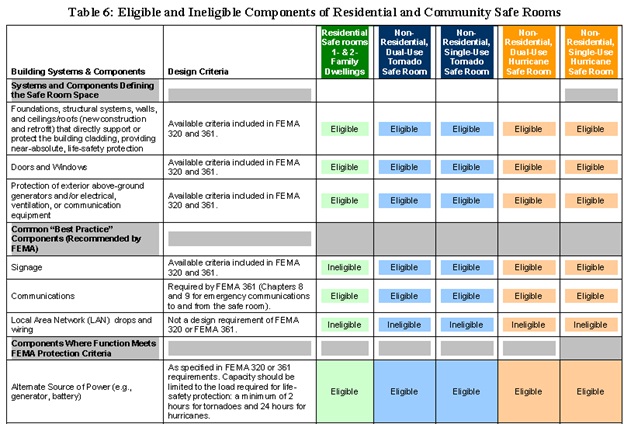
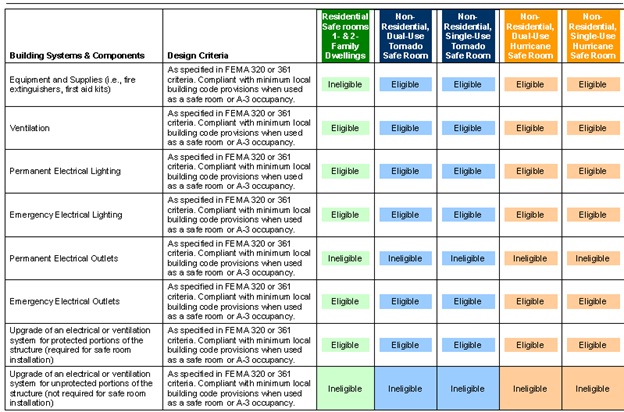
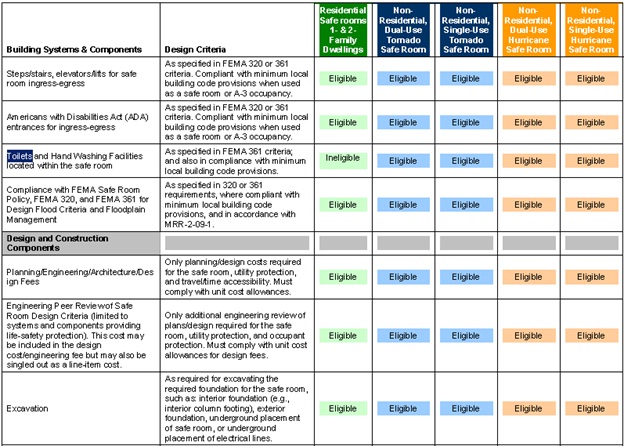
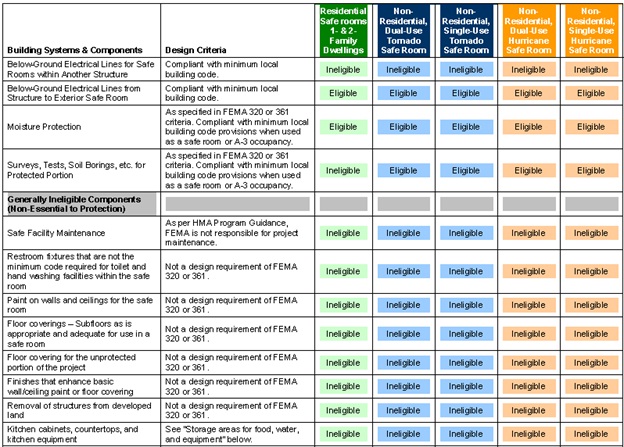
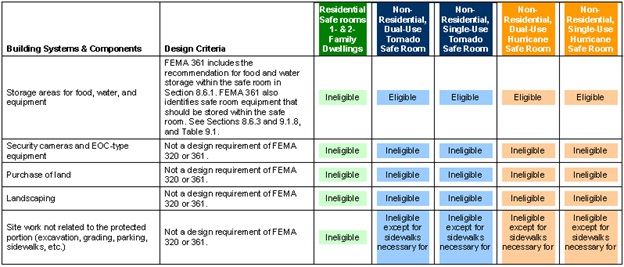
Does FEMA approve, endorse, or certify any products?
No. Federal No. Federal policy does not allow FEMA to approve, endorse, certify, or recommend any products. While a product may be in compliance with FEMA design guidance, any language from manufacturers stating their product is "FEMA approved" or "FEMA certified" is incorrect.
What is the recommended square footage per person for a residential tornado and hurricane safe room?
For residential safe rooms, the usable tornado safe room floor area should be the gross floor area minus the area of sanitary facilities, if any, and should include the protected occupant area between the safe room walls at the height of any fixed seating, if it exists. The minimum recommended safe room floor area per occupant for residential tornado and hurricane safe rooms is provided in table below. (Click the table to view it larger.)

What is the cost of installing a safe room in a new home or small business?
Costs for construction vary across the United States. The cost for constructing a safe room that can double as a master closet, bathroom, or utility room inside a new home or small business ranges from approximately $6,600 to $8,700 (in 2011 dollars). This cost range is applicable to the basic designs in FEMA P-320 (FEMA, 2008a) for an 8-foot by 8-foot safe room (approximately 64 square feet of protected space). Larger, more refined designs for greater comfort cost more, with 14 foot by 14-foot safe rooms ranging in cost from approximately $12,000 to $14,300. The cost of the safe room can vary significantly, depending on the following factors:
- The size of the safe room
- The location of the safe room within the home or small business
- The number of exterior home walls used in the construction of the safe room
- The type of door used
- The type of foundation on which the safe room is constructed
- The location of the home or small business within the United States
For additional cost information for small safe rooms in a home or small business, see FEMA P-320 (FEMA, 2008a), Section II, page 34.
As a homeowner, can I build the safe room on my own?
A homeowner who builds a safe room should be skilled in building construction. Some pre-fabricated safe rooms are available that require less building construction experience to successfully install. In purchasing any safe room, the homeowner should obtain sufficient documentation to determine that the safe room is built to the FEMA safe room design and protection criteria.
Can I install a safe room in an existing home?
Yes, though installing a safe room in an existing home or small business is typically more expensive and challenging than installing one in a new building. Modifying the walls or foundation of an existing building for the construction of a safe room is more complicated than constructing those elements new and, as a result, some of the prescriptive safe room designs provided in FEMA P-320 (FEMA, 2008a) are not practical for some existing homes. Typically, installing a safe room in an existing home costs 20 percent more than installing the same safe room in a new home under construction.
Due to the technical challenges involved in retrofitting an existing home for a safe room,
an architect or engineer should be consulted to address the structural issues and the wind-borne debris protection criteria, even when not required by the local building department. As such, homeowners must balance the desire to have protection within their home with the practicality of constructing a safe room outside the footprint of their existing home or structure for less money. For more information on retrofitting existing buildings with a safe room, see FEMA P-320 (FEMA, 2008a), Section II, page 25.
Is an underground safe room safer than one above ground?
As long as a safe room is designed to meet or exceed the criteria in FEMA P-320 (FEMA, 2008a) and FEMA P-361 (FEMA, 2008b), it will offer the same near-absolute protection whether it is above or below ground.
Where is the best location for the safe room?
There are several possible locations in or near your home or small business for a safe room. The most convenient location in many homes is in the basement. If there is no basement within the home, or if the walls of the basement do not meet FEMA P-320 (FEMA, 2008a) design criteria, an in-ground safe room can be installed beneath a concrete slab-on-grade foundation or concrete garage floor. In-ground and basement safe rooms provide the highest level of protection against missiles and falling debris because they are typically shielded from direct forces of wind and debris; however,
above-ground designs, such as the prescriptive designs provided in FEMA P-320 (FEMA, 2008a) or any solution following the criteria set forth in FEMA P-361 (FEMA, 2008b) will provide near-absolute protection.
Many individuals prefer to build within their homes or buildings so they have some level of
protection while attempting to access their safe room. For an existing home or small business, this convenience must be balanced with the challenges of retrofitting the building. For more information on selecting the location of a safe room within your home or small business, see FEMA P-320 (2008a), Section II, page 27.
Are inspections required?
Obtaining proper building permits and inspections is important for all construction. The builder or homeowner should ensure the safe room is built according to the plans in FEMA P-320 (FEMA, 2008a) or to plans that, through testing and engineering, have been determined to meet the safe room design criteria in FEMA P-320 (FEMA, 2008a) or FEMA P-361 (FEMA, 2008b). The level of construction needed for a safe room typically requires a permit from the local building department. Further, to verify compliance with the FEMA or International Code Council (ICC)-500 (ICC, 2008) criteria, additional quality control inspections for community safe rooms, and often for residential safe rooms, may be needed.
If the Storm shelter costs $6,000.00 can I get more than $2,000 reimbursed?
No, the Hazard Mitigation Program only allows reimbursements up to 75% of the approved costs.
I need to have my Storm Shelter money up front to pay my contractor. Is this possible?
No, The money is only available as a reimbursement, AFTER construction is completed and you have submitted signed and notarized documentation from your contractor stating your Storm Shelter meets or exceeds the specification set forth in FEMA Publication 320.
If I am eligible to receive the $2,000 rebate, do I have to consider that money as income for State and Federal Income Tax purposes?
No, in accordance with the Robert T. Stafford Disaster Relief and Emergency Assistance Act, as amended, these funds are considered free from tax liability under Federally funded assistance programs.
Annual Reports
[Note: The following files are in PDF format. You will need the Adobe Acrobat Reader to view the files. It is a free download from Adobe.com. You can get it by clicking here. Files in PDF format are printer friendly]
2012 Board of Supervisors Agendas/Minutes/Notices
Note: The Board of Supervisors and Board of Equalization will meet in Hearing Room B in the Justice Center during the Courthouse Renovation Project. See the public notice for more information.
Buffalo County furnishes the public information contained herein as a public service. This information may not reflect the most recent resolutions of the County Board and if the resolutions need to be legally relied upon, the most current version may be obtained at the office of the County Clerk. Please also read the disclaimer statement.
Open Meetings Act.
Zoning packets are available upon request from the Zoning Administrator.
Please choose the Agenda you wish to view from the list below.
| January 10, 2012 |
Notice |
Agenda |
Minutes |
| January 24, 2012 |
Notice |
Agenda |
Minutes |
| February 14, 2012 |
Notice |
Agenda |
Minutes |
| February 28, 2012 |
Notice |
Agenda |
Minutes |
| March 13, 2012 |
Notice |
Agenda |
Minutes |
| March 27, 2012 |
Notice |
Agenda |
Minutes |
| April 10, 2012 |
Notice |
Agenda |
Minutes |
| April 24, 2012 |
Notice |
Agenda |
Minutes |
| May 8, 2012 |
Notice |
Agenda |
Minutes |
| May 22, 2012 |
Notice |
Agenda |
Minutes |
| June 12, 2012 |
Notice |
Agenda |
Minutes |
| June 26, 2012 |
Notice |
Agenda |
Minutes
|
June 27, 2012
Emergency Meeting
|
Notice |
Agenda |
Minutes |
| July 10, 2012 |
Notice |
Agenda |
Minutes |
July 11, 2012
Emergency Meeting
|
Notice |
Agenda |
Minutes |
| July 24, 2012 |
Notice |
Agenda |
Minutes |
| August 14, 2012 |
Notice |
Agenda |
Minutes |
| August 28, 2012 |
Notice |
Agenda |
Minutes |
| September 11, 2012 |
Notice |
Agenda |
Minutes |
| September 25, 2012 |
Notice |
Agenda |
Minutes |
| October 9, 2012 |
Notice |
Agenda |
Minutes |
| October 22, 2012 |
Notice |
Agenda |
Minutes |
| November 13, 2012 |
Notice |
Agenda |
Minutes |
| November 27, 2012 |
Notice |
Agenda |
Minutes |
| December 11, 2012 |
Notice |
Agenda |
Minutes |
| December 27, 2012 |
Notice |
Agenda |
Minutes |
2016 Archive
2015 Archive
2014 Archive
2013 Archive
2012 Archive
2011 Archive
2010 Archive
2003 Local Emergency Planning Committee Meeting Minutes
Buffalo County furnishes the public information contained herein as a public service. This information may not reflect the most recent resolutions of the LEPC and if the resolutions need to be legally relied upon, the most current version may be obtained at the Emergency Manager office. Please also read the disclaimer statement.
Please choose the agenda or minutes you wish to view from the list below.
[Note: The following files are in PDF format. You will need the Adobe Acrobat Reader to view the files. It is a free download from Adobe.com. Files in PDF format are printer friendly]
2006 Archive
2005 Archive
2004 Archive
2003 Archive
2004 Local Emergency Planning Committee Meeting Minutes
Buffalo County furnishes the public information contained herein as a public service. This information may not reflect the most recent resolutions of the LEPC and if the resolutions need to be legally relied upon, the most current version may be obtained at the Emergency Manager office. Please also read the disclaimer statement.
Please choose the agenda or minutes you wish to view from the list below.
[Note: The following files are in PDF format. You will need the Adobe Acrobat Reader to view the files. It is a free download from Adobe.com.. Files in PDF format are printer friendly]
2006 Archive
2005 Archive
2004 Archive
2003 Archive
2005 Local Emergency Planning Committee Meeting Minutes
Buffalo County furnishes the public information contained herein as a public service. This information may not reflect the most recent resolutions of the LEPC and if the resolutions need to be legally relied upon, the most current version may be obtained at the Emergency Manager office. Please also read the disclaimer statement.
Please choose the agenda or minutes you wish to view from the list below.
[Note: The following files are in PDF format. You will need the Adobe Acrobat Reader to view the files. It is a free download from Adobe.com.. Files in PDF format are printer friendly]
2006 Archive
2005 Archive
2004 Archive
2003 Archive
2006 Mutual Aid Meeting Minutes
Buffalo County furnishes the public information contained herein as a public service. This information may not reflect the most recent resolutions of the County Board and if the resolutions need to be legally relied upon, the most current version may be obtained at the office of the Buffalo County Clerk or the appropriate county office.
Please also read the disclaimer statement.
Please choose the agenda or minutes you wish to view from the list below.
[Note: The following files are in PDF format. You will need the Adobe Acrobat Reader to view the files. It is a free download from Adobe.com. You can get it by clicking here. Files in PDF format are printer friendly]
2007 Archive
2006 Archive
Mutual Aid Members
| |
| Amherst Volunteer Fire Department |
| Elm Creek Volunteer Fire Department |
| Gibbon Volunteer Fire Department |
| Kearney Volunteer Fire Department |
| Miller Volunteer Fire Department |
| Pleasanton Volunteer Fire Department |
| Ravenna Volunteer Fire Department |
| Shelton Volunteer Fire Department |
| Buffalo County Emergency Management |
| Buffalo County Sheriff's Office |
| Kearney Police Department |
| Good Samaritan Hospital |
Emergency Food & Water Supply
If a tornado, ice storm, winter storm or other disaster ever strikes your community, you might not have access to food, water and electricity for days. By taking a little time now to store emergency food and water supplies, you can provide for your entire family.
WATER: THE ABSOLUTE NECESSITY
Stocking water reserves should be among your top priorities in preparing for an emergency. You should store at least a three-day supply of water for each member of your family. Everyone's needs will differ, depending upon age, physical condition, activity, diet and time of year. A normally
active person needs to drink at least two quarts of water each day, but the heat of summer can cause a person to need double that amount. Children, nursing mothers and ill people will also need more. You will need additional water for food
preparation and hygiene, so it is recommended that you store a total of at least one gallon per person, per day.
How To Store Emergency Water Supplies
You can store your water in thoroughly washed plastic, glass,
fiberglass or enamel-lined metal containers. Never use a container that has held toxic substances, because tiny amounts may remain in the container's pores. Sound plastic containers, such as soft drink bottles, are best.
Before storing your water, treat it with a preservative, such as chlorine bleach, to prevent the growth of microorganisms. Use liquid bleach that contains 5.25 percent sodium hypochlorite and no soap. Add four drops of bleach per quart of water (or
two scant teaspoons per 10 gallons), and stir. Seal your water containers tightly, label them and store them in a cool, dark place.
Another method to store water is to simply purchase bottled water and leave the seals intact, but remember to rotate your water every six months or as date stamped on the bottles.
Hidden Water Sources in Your Home
If a disaster catches you without a stored supply of clean water,
you can use water in your hot-water tank, in your plumbing and in ice cubes. As a last resort, you can use water in the reservoir tank of your toilet (not the bowl), but purify it
first (described later).
Water beds hold up to 400 gallons, but some water beds contain toxic chemicals that are not fully removed by many purifiers. If you designate a water bed in your home as an emergency resource, drain it yearly and refill it with fresh water containing two ounces of bleach per 120 gallons.
To use the water in your pipes, let air into the plumbing by turning on the highest faucet in your house and draining the water from the lowest one.
To use the water in your hot-water tank, be sure the electricity or gas is off, and open the drain at the bottom of the tank. Start the water flowing by turning off the water intake valve and turning on a hot-water faucet. Do not turn on the gas or electricity when the tank is empty.
Do you know the location of your incoming water valve? You'll need to shut if off to stop contaminated water from entering your home if you hear reports of broken water or sewage lines.
Family Disaster Supply Kit
It's 2:00 a.m. and a railroad derailment has caused officials to order an evacuation of half of the community. There's no time to gather food from the kitchen, fill bottles with water, grab a first-aid kit from the closet and snatch a flashlight and a portable radio from the bedroom. You need to have these items packed and ready in one place before disaster hits.
Pack at least a three-day supply of food and water, and store it in a handy place. Choose foods that are easy to carry, nutritious and ready-to-eat. In addition, pack these emergency items:
- Medical
supplies and first aid manual
- Hygiene
supplies
- Portable
radio, flashlights and extra batteries
- Shovel
and other useful tools
- Money
and matches in a waterproof container
- Fire
extinguisher
- Blanket
and extra clothing
- Infant
and small children's needs (if appropriate)
FOOD: PREPARING AN EMERGENCY STOCKPILE
If activity is reduced, healthy people can survive on half their usual food intake for an extended period and without any food for many days. Food, unlike water, may be rationed safely, except for children and pregnant women.
If your water supply is limited, try to avoid foods that are high in fat and protein, and don't stock salty foods, since they will make you thirsty. Try to eat salt-free crackers, whole grain cereals and canned foods with high liquid content.
You don't need to go out and buy unfamiliar foods to prepare an emergency food supply. You can use the canned foods, dry mixes and other staples on your cupboard shelves. In fact, familiar foods are important. They can lift morale and give a feeling
of security in time of stress. Also, canned foods won't require cooking, water or special preparation. The following are recommended short-term and long-term food storage plans.
Storage Tips
- Keep
food in the driest and coolest spot in the house, a dark area if possible.
- Keep
food covered at all times.
- Open
food boxes or cans carefully so that you can close them tightly after each use.
- Wrap
cookies and crackers in plastic bags, and keep them in tight containers.
- Empty
opened packages of sugar, dried fruits and nuts into screw-top jars or air-tight cans to protect them from pests.
- Inspect
all food containers for signs of spoilage before use.
Short-Term Food Supplies
Even though it is unlikely that an emergency would cut off your food supply for a week, you should prepare a supply that will last that long. A supply that will last for a week can relieve a great deal of inconvenience and uncertainty until services are restored.
The easiest way to develop a stockpile is to increase the amount of basic foods you normally keep on your shelves. Remember to compensate for the amount you eat from other sources (such as restaurants) during an average week.
You may already have a supply of food on hand that will last for a week. Keeping it fresh is simple. Just rotate your supply once or twice a year.
Special Considerations to Keep in Mind
As you stock food, take into account your family's unique needs and tastes. Try to include foods that they will enjoy and that are also high in calories and nutrition. Foods that require no refrigeration, preparation or cooking are best.
Individuals with special diets and allergies will need particular attention, as will babies, toddlers and the elderly. Nursing mothers may need liquid formula, in case they are unable to nurse. Canned dietetic foods, juices and soups may be helpful for the ill or elderly.
Make sure you have a can opener and disposable utensils. And don't forget nonperishable foods for your pets.
How to Store Your Short-Term Stockpile
Keep canned foods in a dry place where the temperature is fairly cool--not above 70 degrees Fahrenheit and not below freezing.
Rotate your food supply. Use foods before they go bad, and replace
them with fresh supplies, dated with ink or marker. Place new items at the back of the storage area and older ones in front.
How to Cook if the Power Goes Out
For emergency cooking you can use your propane or charcoal grill or camp stove outdoors only. Canned food can be eaten right out of the can. If you heat it in the can, be sure to open the can and remove the label first.
Nutrition Tips
In a crisis, it will be vital that you maintain your strength. So remember:
- Eat at least one well-balanced meal each day.
- Drink enough liquid to enable your body to function properly (two quarts a day).
- Take in enough calories to enable you to do any necessary work.
Family Disaster Plan
Disaster can strike quickly and without warning. It can force youto evacuate your neighborhood or confine you to your home. What would you do if basic services--water, gas, electricity or telephones--were cut off? Local officials and relief workers will be on the scene after a disaster, but they will not be able to reach everyone right away, so it is important for you to develop a plan for you and your family.
Families can, and do, cope with disaster by preparing in advance and working together as a team. Follow the steps below to create your family's disaster plan. Knowing what to do is your best protection and your responsibility.
Where will your family be when disaster strikes? They could be anywhere--at work, at school or in the car.
How will you find each other? Will you know if your children are safe?
4 STEPS TO SAFETY
1. Find Out What Could Happen to You
Contact the Emergency Management office or the Ft. Kearney Chapter of the American Red Cross.
- Ask what types of disasters are most likely to happen in Kearney and the surrounding area. Request information on how to prepare for the different types of emergencies that could occur.
- Learn about the existing warning signals in Buffalo County: what they sound like (outdoor warning sirens), and that the alert signal should indicate to all citizens to tune to local radio or television for emergency information and instructions.
- Ask about animal care after a disaster. Animals will not be allowed inside emergency shelters due to health regulations, so prepare a plan for your pets.
- Find out how to help elderly or disabled persons, if needed.
- Next, find out about the disaster plans at your workplace, your children's school or daycare center and other places where your family spends time.
2. Create a Disaster Plan
Meet wiith your family and discuss why you need to prepare for disaster. Explain the dangers of fire, severe weather and hazardous materials to children. Plan to share responsibilities and work together as a team.
- Discuss the types of disasters that are most likely to happen. Explain what to do in each case.
- Pick two places to meet;
- Right outside your home in case of a sudden emergency, like a fire.
- Outside your neighborhood in case you can't return home. Everyone must know the address and phone number.
- Ask an out-of-state friend to be your "family contact." After a disaster, its often easier to call long distance. Other family members should call this person and tell them
where they are. Everyone must know your contact's phone number.
- Discuss what to do in an evacuation. Plan how to take care of your pets.
3. Complete This Checklist
- Post emergency telephone numbers by your telephones or have them programmed into your phone (fire, police, EMS, etc.)
- Teach children how and when to call 911 for emergency help.
- Show each family member how and when to turn off the water, gas and electricity at the main switches.
- Check if you have adequate insurance coverage.
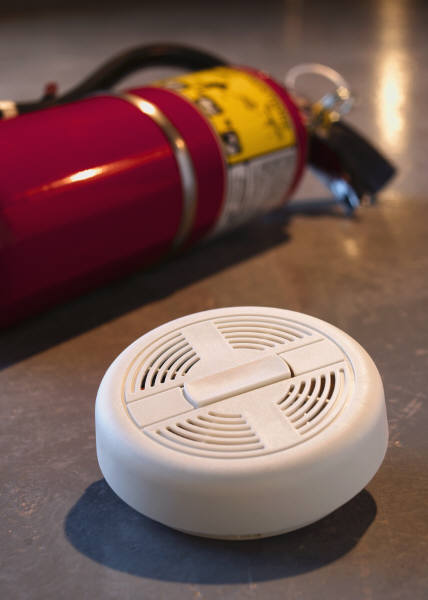
- Teach each family member how to use a fire extinguisher (ABC type), and show them the designated locations where they are kept in the house.
- Install smoke detectors on each level of your home, especially near bedrooms.
- Conduct a home hazard hunt.
- Stock emergency supplies and assemble a Disaster Supplies Kit.
- Take a Red Cross first aid and CPR class.
- Determine the best escape routes from your home. Find two ways out of each room.
- Find the safe spots in your home for each type of disaster, including your Shelter-in-Place spot.
4. Practice and Maintain Your Plan
- Quiz your children every six months so they remember what to do.
- Conduct fire and emergency evacuation drills.
- Replace stored water every three months and stored food every six months.
- Test and recharge your fire extinguisher(s) according to manufacturer's instructions.
- Test your smoke detectors monthly and replace the batteries the same weekend as the time change occurs in the spring (daylight-savings time) and fall (standard time).
EMERGENCY SUPPLIES
Keep enough supplies in your home to meet your needs for at least three days. Assemble a Disaster Supplies Kit with items you may need in an evacuation. Store these supplies in sturdy, easy-to-carry containers such as backpacks, duffle bags or covered plastic containers. Include:
- A three-day supply of water (one gallon per person per day) and food that won't spoil.

- One change of clothing and footwear per person, and one blanket or sleeping bag per person.
- A first aid kit that includes your family's prescription medications.
- Emergency tools, including a battery-powered radio, flashlight and plenty of extra batteries.
- An extra set of car keys and a credit card, cash or traveler's checks.
- Sanitation supplies.
- Special items for infant, elderly or disabled family members.
- An extra pair of glasses.
- Keep important family documents in a waterproof container. Keep a smaller kit in the trunk of your car.
UTILITIES
Locate the main electric fuse box, water service main and natural gas main. Learn how and when to turn these utilities off. Teach all responsible family members. Keep necessary tools near gas and water shut-off valves.
Remember, turn off the utilities only if you suspect the lines are damaged or if you are instructed to do so. If you turn the gas off, you will need a professional to turn it back on.
NEIGHBORS HELPING NEIGHBORS
Working with neighbors can save lives and property. Meet with your neighbors to plan how the neighborhood could work together after a disaster until help arrives. If you're a
member of a neighborhood organization, such as a home association or neighborhood watch group, introduce disaster preparedness as a new activity. Know your neighbors' special skills (e.g., medical, technical) and consider how you could help neighbors who have special needs, such as disabled and elderly persons. Make plans for child-care in case parents are unable to get home during the emergency.
HOME HAZARD HUNT
During a disaster, ordinary objects in your home can cause injury or damage. Anything that can move, fall, break or cause a fire is a home hazard. Inspect your home at least once a year and fix potential hazards.
Contact the Kearney Volunteer Fire Department to learn about home fire hazards.
EVACUATION
Evacuate immediately if told to do so:
- Listen to your battery-powered radio and follow the instructions of local emergency officials.
- Wear protective clothing and sturdy shoes.
- Take your family disaster supplies kit.
- Lock your home.
- Use travel routes specified by local authorities--don't use shortcuts because certain areas may be impassable or dangerous.
If you're sure you have time:
- If instructed to do so, shut off water, gas and electricity before leaving.
- Post a note telling others when you left and where you are going.
- Make arrangements for your pets.
IF DISASTER STRIKES
- If disaster strikes
Remain calm and patient. Put your plan into action.
- Check for injuries
Give first aid and get help for seriously injured people.
- Listen to your battery powered radio for news and instructions.
- Evacuate, if advised to do so. Wear protective clothing and sturdy shoes.
Check for damage in your home...
- Use flashlights--do not light matches or turn on electrical switches, if you suspect damage.

- Check for fires, fire hazards and other household hazards.
- Sniff for gas leaks, starting at the water heater. If you smell gas or suspect a leak, turn off the main gas valve, open windows, and get everyone outside quickly.
- Shut off any other damaged utilities.
- Clean up spilled medicines, bleaches, gasoline and other flammable liquids immediately.
Remember to...
- Confine or secure your pets.
- Call your family contact--do not use the telephone again unless it is a life-threatening emergency.
- Check on your neighbors, especially elderly or disabled persons.
- Make sure you have an adequate water supply in case service is cut off.
- Stay away from downed power lines.
The Federal Emergency Management Agency's Family Protection Program and the American Red Cross' Disaster Education Program are nationwide efforts to help citizens prepare for disasters of all types. For more information, please contact the Emergency Management office, or the Fort Kearney Chapter of the American Red Cross. Start planning now.
Organizational Chart
The Emergency Manager is an appointed position responsible
for the development, implementation and maintenance of an
emergency management system in Buffalo County to save lives
and protect property. Such emergency management system shall
include disaster mitigation, preparedness, response and recovery
capabilities. The incumbent is charged with making certain
that the components of the emergency management system know
the threats to the jurisdiction, planning for emergencies,
being able to function effectively in an emergency, and conducting
recovery operations following a disaster.
The position requires direct responsibility for the organization,
administration, and operation of the Buffalo County Emergency
Management System, subject to the direction and control of
the Buffalo County Board of Commissioners. The position serves
as the principal advisor to the Buffalo County Board of Commissioners
in disaster/emergency matters. Supervision of day-to-day activities
shall be directed by the Buffalo County Sheriff and Kearney
Chief of Police.
The incumbent, in discharging duties, must work with elected
and appointed officials of the local governments, of the state
and of the Federal government, and private sector interests.
The incumbent is given broad and extensive authority to determine
program priorities, requirements and procedures so as to implement
and support the local, state and national programs and objectives.
Completed work is reviewed in terms of net results and the
achievement of broad objectives and conformance with general
policies. Job effectiveness can be determined by the ability
of the Buffalo County Emergency Manager to take the lead in
developing local capabilities to mitigate disasters/emergencies
and conduct coordinated operations in disasters/emergencies,
making maximum use of all public and private resources available.
Pets & Animals in a Disaster
Whether it's a large-scale natural catastrophe or an unforeseen emergency that causes you to leave your home temporarily, everyone's family can benefit from having a household evacuation plan in place before disaster strikes.
Every disaster plan must include your pets!
The Humane Society of the United States (HSUS) offers the following tips to pet owners designing an emergency safety plan:
- If you evacuate your home, DO NOT LEAVE YOUR PETS BEHIND! Pets most likely cannot survive on their own; and if by some remote chance they do, you may not be able to find them when you return.
- For public health reasons, many emergency shelters cannot accept pets. Find out which motels and hotels in your area allow pets -- well in advance of needing them. Include your local animal shelter's number in your list of emergency numbers -- they might be able to provide information concerning pets during a disaster.
- Make sure identification tags are up to date and securely fastened to your pet's collar. If possible, attach the address and/or phone number of your evacuation site. If your pet gets lost, his tag is his ticket home. Make sure you have a current photo of your pet for identification purposes.
- Make sure you have a secure pet carrier, leash or harness for your pet so that if he panics, he can't escape.
- Take pet food, bottled water, medications, veterinary records, cat litter/pan, can opener, food dishes, first aid kit and other supplies with you in case they're not available later. While the sun is still shining, consider packing a "pet survival" kit, which could be easily deployed if disaster hits.
- If you are unable to return to your home right away, you may need to board your pet. Most boarding kennels, veterinarians and animal shelters will need your pet's medical records to make sure all vaccinations are current. Include copies in your "pet survival" kit along with a photo of your pet.
- If it is impossible to take your pet with you to temporary shelter, contact friends, family, veterinarians, or boarding kennels to arrange for care. Make sure medical and feeding information, food, medicine and other supplies accompany your pet to his foster home. NOTE: Some animal shelters will provide temporary foster care for owned pets in times of disaster, but this should be considered only as a last resort.
- If you have no alternative but to leave your pet at home, there are some precautions you must take, but remember that leaving your pet at home alone can place your animal in great danger! Confine your pet to a safe area inside -- NEVER leave your pet chained outside! Place a notice outside in a visible area, advising what pets are in the house and where they are located. Provide a phone number where you or a contact can be reached as well as the name and number of your vet.

Not only are pets affected by disaster, but the other animals in the disaster area are affected as well. The HSUS offers these basic tips for people who encounter wildlife or have livestock on their property:
Wildlife
- Wild animals often seek higher ground, which, during floods, eventually become submerged (i.e., island) and the animals become stranded. If the island is large enough and provides suitable shelter, you can leave food appropriate to the species (i.e., sunflower seeds for squirrels). Animals have a flight response and will flee from anyone approaching too closely. If the animal threatens to rush into the water, back away from the island or you may frighten the animal into jumping into the water to escape from you
- Wildlife often seek refuge from flood waters on upper levels of a home and may remain inside even after the water recedes. If you meet a rat or snake face to face, be careful but don't panic. Open a window or other escape route and the animal will probably leave on its own. Never attempt to capture a wild animal unless you have the training, protective clothing, restraint equipment and caging necessary to perform
the job.
- Beware of an increased number of snakes and other predators who will try to feed on the carcasses of small mammals who have been drowned or crushed in their burrows or under rocks.
- Often, during natural disasters, mosquitoes and dead animal carcasses may present disease problems. Outbreaks of disease may occur. The local public health office will issue news releases to assist with aiding the public regarding health issues associated with the disaster.
- If you see an injured or stranded animal in need of assistance, or you need help with evicting an animal from your home, please contact your local animal control office or Nebraska Games and Parks.
Livestock
Evacuate Livestock Whenever Possible.
- Arrangements for evacuation, including routes and host sites, should be made in advance. Alternate routes should be mapped out in case the planned route is inaccessible.
- The evacuation sites should have or be able to readily obtain food, water, veterinary care, handling equipment and facilities.
- Trucks, trailers, and other vehicles suitable for transporting livestock (appropriate for transporting each specific type of animal) should be available along with experienced handlers and drivers to transport them. Whenever possible, the animals should be accustomed to these vehicles in advance so they're less frightened and easier to move.
- If evacuation is not possible, a decision must be made whether to move large animals to available shelter or turn them outside. This decision should be determined based on the type of disaster and the soundness and location of the shelter (structure).
- All animals should have some form of identification that will help facilitate their return.
Your disaster plan should include a list of emergency phone numbers for local agencies that can assist you if disaster strikes -- including your veterinarian, state veterinarian, local animal shelter, animal care and control, and county extension service. These numbers should be kept with your disaster kit in a secure, but easily accessible place.
For additional information, please contact:
The Humane Society of the United States
2100 L. Street, NW
Washington, DC. 20037
Attn: Disaster Services Program
Phone: (202) 452-1100
Website: http://www.hsus.org
Policy for Subdivision Road Maintenance
Buffalo County will (may) provide public road top only maintenance
within established subdivisions on the following basis:
Subdivision must be properly platted and recorded with established
roads dedicated to the public.
Subdivision must present the County Board of Commissioners
a petition for such maintenance signed by a majority of property
owners.
Maintenance will be on a "Low-priority" basis,
as compared to "Regular or High-priority" main roads,
school bus routes, emergency roads, section line and half section
line roadways.
The County may require the subdivision to improve roads to
minimum standards if there is difficulty operating maintenance
vehicles because of such conditions. The cost of their improvement
or any other significant road improvements shall be the financial
responsibility of the subdivision.
Each subdivision should have an alternate snow removal plan
in the event that emergency situations dictate the use of
equipment elsewhere.
It is further recommended that each subdivision's governing
body or committee appoint one representative within the subdivision
to communicate problems or questions to the County Road Department.
Poll Worker Information
Have you ever considered serving as a poll worker?
If you have the following qualifications you would make an excellent poll worker!
P atriotic 
O rganized
L aw-abiding
L iterate
W illing
O ptimistic
R esponsive
K ind
E nergetic
R esourceful
Every two years the Buffalo County Election Office must appoint an election board to serve in each precinct on Election Day. A poll worker must be a Buffalo County registered voter and able to work on Election Day from approximately 7:00 a.m. to approximately 8:00 - 8:30 p.m. The appointment is for a two-year term and you will be expected to work at every election in that term. If an emergency comes up and you are not able to work, you will need to call the election office to be replaced.
Once appointed, even if you volunteer, poll workers have the same civil leave protection as those who serve on jury duty. Your employer must allow you the time to serve without threat of loss of personal or holiday pay, sick leave, loss of overtime pay, or any other form of penalty for absence from work when serving as an election official.
Should you decide to become a poll worker, you will be expected to attend a training class prior to the next election.
Election Hours - The inspector will inform you of the time you are required to report to the polling place (usually 7:00 a.m.). You may leave as soon as the work is finished after the polls close at 8:00 p.m.
Physical Requirements with or without accommodations
1. Good eye sight and hearing.
2. Able to sit from 8:00 a.m. to 8:00 p.m.
3. Inspectors must be able to lift up to 40 pounds.
Pay Scale - Election judges and clerks are paid $13 per hour and Inspectors are paid $14 per hour. Rural Inspectors picking up and returning election supplies will receive mileage at whatever the current IRS rate is at the time of the election.
Training - A training session is held prior to each Primary and General election. This is held approximately 1 week before the election date and lasts about 1 1/2 to 2 hours. Poll workers will be given a manual at training and paid a set amount of $30 for attending the training. Payment will be made when your check is issued for working the election.
Inspectors - Inspectors are in charge of the polling place election day. They are responsible for supervising board members and informing the election office if any of the board members are not adequately performing their duties. Prior to each election, the Inspectors pick up the supplies, check the polling place, make sure all necessary arrangements are made for election day and call their board members to inform them of election day plans. Election supplies are returned by the inspectors to the Election Office as soon as the polls close.
If you have questions, please contact the Election Commission at 308-236-1233.
Severe Weather
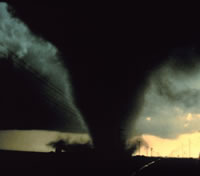 Severe storms strike quickly! Thunderstorms can produce heavy rain, strong winds, lightning, hail and tornadoes. You may need to respond promptly to one of these threats posed by a storm in your area. Severe storms strike quickly! Thunderstorms can produce heavy rain, strong winds, lightning, hail and tornadoes. You may need to respond promptly to one of these threats posed by a storm in your area.
The National Weather Service, in cooperation with the broadcast media, BuffaloWatch and the local spotter system, will provide you with the warnings you need to quickly respond. If you listen to the media, you will know when a storm is approaching your area and you will know if you need to take protective action.
Watch or Warning
A Severe Thunderstorm Watch means conditions are right for the  development of storms. Stay tuned to the media for further advisories. development of storms. Stay tuned to the media for further advisories.
A Severe Thunderstorm Warning means a storm is probable in the warned area and residents there should be prepared to take cover.
Don’t wait until an emergency siren sounds to start looking for flashlights and other things. Plan ahead. When severe storms threaten, keep alert. Stay tuned to the media for current information. Know where to find shelter. Pick the safest spot. Make sure the entire family knows where to go – at home, at work, in school, at the mal l- anywhere they might be when the storms strike. Avoid traveling.
If you live in a mobile home, you should make sure the mobile home is securely anchored. During storm warnings, you should seek more secure cover and have a plan that includes abandoning your mobile home.
Flash flooding
Floods kill more people on average than tornadoes and lightning combined! Most flood deaths are due to flash floods. Flash floods are often the result of heavy rains associated with severe thunderstorms. You will not always have a warning that these deadly, sudden floods are coming.
When a Flash Flood Watch is issued, be alert and be ready to evacuate on a moment’s notice. When a Flash Flood Warning is issued, or the moment you realize a flash flood is imminent, act quickly to save yourself. You may only have seconds.
Nearly half of all flash flood fatalities are auto related. In your automobile, look out for flooding at highway dips, bridges and low areas. Do not drive through flowing water. A mere two feet of water will carry away most automobiles.
Lightning
Lightning kills between 75 and 100 people nationwide annually.
During thunderstorms, stay inside. If you are outdoors, an automobile is a safe place to be. Indoors, keep away from doors, windows, stoves, sinks, metal pipes or other conductors. Disconnect electrical appliances such as TV’s, radios and computers.
Outdoors, minimize your height but don’t lie flat. Do not take shelter under a tree. Stay away from wire fences, overhead power lines and other metallic conductors. Avoid standing in small sheds in open areas.
Tornadoes
The most destructive and devastating product of a thunderstorm, these violent "twisters", are characterized by a twisting, funnel-shaped cloud, which forms from the bottom of a wall cloud and touches the ground.
Tornadoes are often accompanied by lightning, heavy rain and hail. In an average year, the United States reports 800 tornadoes resulting in 80 deaths and 1,500 injuries.
While they can occur all year, they are most common during the spring in the Great Plains, where they develop along “drylines,” which separate very warm, moist air to the east from hot, dry air to the west. Tornado-producing thunderstorms may form as the dryline moves east during the afternoon hours.
Nebraska is in the middle of tornado alley and each year the state averages 35 tornadoes.
Knowing tornado safety is your best hope for surviving. You must have a PLAN.
Stay tuned to the media when the watches are sounded and be prepared to seek shelter if a tornado warning is issued in your area. The safest place to be when a tornado strikes is in a basement under something sturdy like a workbench.
If your house doesn’t have a basement, seek shelter in a small room in the middle of the house. A closet or bathroom is best. The more walls between you and the approaching storm the better.
Have a portable radio and flashlight handy to take with you.
If you live in a mobile home, even those with tie-downs, seek more permanent shelter. Go to a prearranged shelter. Go to a friend’s house or a nearby structure with a basement. As a last resort, go outside and lie flat on the ground with your hands over your head and neck.
In an automobile, never try to outrun a tornado. Tornadoes can toss cars, and even large trucks, around like toys. Get out of your vehicle and seek a safe structure or lie down in a low area with your hands covering the back of your head and neck; keep alert for flash floods.
At Work or School, know the emergency shelter plans. If no specific plans exist, go to an interior hallway or small room on the building’s lowest level. Avoid areas with glass and wide, freespan roofs.
In a store or shopping mall, if you can’t get to a basement or designated shelter, go to the center of the lowest level of the building. Avoid windows and lie flat. Cover yourself with any handy object.
Most towns in Nebraska sound the sirens when tornado warnings are issued or a funnel cloud is sighted. Some times there are no warnings though. The best bet is to be aware of weather conditions and be prepared to seek shelter.
A Tornado Watch is issued when conditions are favorable for them to develop. Be prepared to take action.
A Tornado Warning is issued when radar indicates a tornado, or if a funnel cloud has been sighted. Seek shelter immediately.
Potential Shelter List

Shelter in Place
What is Shelter-in-Place?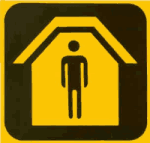
In a situation where a serious hazardous chemical spill has quickly caused a toxic atmosphere, it may be more dangerous to go through those toxic vapors or to attempt to outrun them than to stay in an existing structure. Shelter-in-Place means to get to the inside of a building and remain there during a chemical emergency rather than attempting to evacuate the area. Shelter-in-Place is a viable option for protection against exposure to potentially dangerous airborne chemicals during an emergency.
Why Should I Shelter-in-Place?
During a hazardous materials incident, the idea is to keep everyone's exposure to any chemical as low as possible. It is best to get out of the area and have no exposure, but in a sudden chemical release there may not be time to safely evacuate. In such cases, attempts to evacuate could place you at greater risk of exposure than if you had stayed in your home or workplace. Shelter-in-place is used when there has been a serious hazardous chemical spill that has quickly caused a toxic atmosphere and there is not enough time to safely leave the area. When you shelter-in-place, you take protective action in a structure to reduce exposure to toxic chemical levels. So, unless otherwise instructed to evacuate, sheltering-in-place could be the best way to safely wait out a hazardous chemical release.
How safe is it to Shelter-in-Place?
In a 2001 report by The National Institute for Chemical Studies, several studies were cited that demonstrate the value of sheltering-in-place during a chemical emergency. In older homes, the average house was found to change its air at a rate of less than 1/3
change per hour. It was also found that if one room in the house was sealed up with duct tape and plastic, the amount of chemical that was in the room after one hour was between 1/7 to 1/17 of what was outside. Another study found that sealing up a house also filtered out some of the chemicals. Not only did a sealed up house limit the amount of air coming into a house, the walls actually did some filtering of the air that seeped in. Sheltering-in-place cannot completely eliminate all exposure to the chemical, but it can keep the exposure below dangerous levels.
The report concluded: "For the vast majority of events that have led to the public to shelter-in-place, there have been no reported injuries. In fact, for a very few cases, clouds of toxic materials of sufficient concentration to cause harm have entered communities and, because sheltering-in-place has been accepted by the community and was successfully implemented, no one was injured. The body of evidence suggests that
if there is insufficient time to complete an evacuation, or the chemical leak will be of limited duration, or conditions would make an evacuation more risky than staying in place,
sheltering-in-place is a good way to protect the public during chemical emergencies."
When should I Shelter-in-Place?
A hazardous materials accident can occur anywhere. There may even be a time when you are close to where a chemical accident has taken place. If you feel or hear a strange sound like an explosion; if you see a strange cloud; if you smell a strange odor; if you feel nauseous or have burning or tearing eyes; trust your senses, don't wait for a warning confirmation and act immediately. If it is obvious that you can safely evacuate the area, do so, but remember shelter-in-place as the next option.
In Buffalo County Monitor:
|
KGFW/KQKY
|
1340 AM
|
105.9 FM
|
|
KKPR
|
1460 AM
|
98.9 FM
|
|
KHGI-TV (NTV)
|
|
Channel 13
|
|
NOAA weather radio
|
|
162.475
|
If there is a chemical release in Buffalo County, the emergency alert system will be utilized. The outdoor warning sirens will sound to alert the public to turn on a radio or television for further emergency information.
Where do I Shelter-in-Place?
If you are told to shelter-in-place or if you believe you need to, you should go inside any building close by immediately. If you are not by your own house, a church, school, or store are good options. If you are not near any buildings, your car is a better choice than staying outside. Your home is the best choice to shelter-in-place because you will know
where tapes, towels, plastics and other items are located to help you create your shelter space.
How do I Shelter-in-Place?
- Close all doors to the outside and close and lock all windows (windows sometimes seal better when locked.)
- Ventilation systems should be turned off so no outside air is drawn into the structure.
- Turn off all heating systems and all air-conditioners and switch inlets to the "closed" position.
- Seal any gaps around window type air-conditioners with tape and plastic sheeting, wax paper, or aluminum wrap.
- Turn off all the exhaust fans in kitchens, bathrooms and attics, and cover the openings with plastic wrap or plastic sheeting.
- Close all fireplace dampers and seal with plastic if possible.
- Close as many internal doors as possible in the structure you are in.
- Pick a room on the highest level of the structure, as most of the chemicals that are of concern are heavier than air and will settle in the basement.
- Select a room in the building that is comfortable and easy to seal off. The room should, if possible, provide access to water, toilet facilities, and have adequate room for people and pets to sit.
- If the vapor begins to bother you place a wet cloth over your nose and mouth. For a higher degree of protection, go into the bathroom, close the door and turn on the shower in a strong spray to "wash" the air. Seal any opening to the outside of the bathroom as best you can.
- Make sure you have a battery-powered radio and a flashlight in case the power goes out.
- Once in the room, seal windows, air vents, and exhaust fans with plastic sheeting and duct tape.
- In some homes, light switches and electrical outlets on outside walls are sources of air infiltration and should also be sealed with duct tape and plastic.
- Lastly, seal around the door with duct tape. If the space under the door is too big to seal with tape, try stuffing a damp towel under the door.
- Continue to listen to the radio or TV for emergency information and updates on the incident.
- Don't call 911 unless you have an emergency like a fire or a serious injury.
- Keep your phone available in case someone needs to contact you.
What if I can't make it to a building?
If you can get to your car, go there. Turn off the ventilation system, close your windows and vents, and tune your radio to a local station. If you are driving, try to avoid driving
through a vapor cloud and try to drive crosswind. If you are in a chemical cloud, be aware that your car may stall. If your car stalls or was not running when enveloped by the cloud, DO NOT try to start it unless told to do so by a public announcement on the radio.
If you are outside and not close to a building, such as being on a golf course or in a rural area, try to move crosswind. The vapors may drift downwind for miles and unless there is no wind at all you will not be able to outrun them. Going perpendicular to the wind, away from the center of the cloud will get you to a less harmful atmosphere quicker.
How will I know when it is safe to come out?
As soon as it is deemed safe, authorities will tell you it is safe to leave your building.
Disaster Supplies to have on hand:
- Flashlight and extra batteries
- Portable battery-operated radio
- Duct tape and plastic sheeting & wrap
- Games and toys to occupy children
- First aid kit and essential medicines
- Emergency food and water
SPECIAL NOTE: SHELTER-IN-PLACE DOES NOT APPLY TO FLAMMABLE GASES SUCH AS PROPANE AND NATURAL GASES.
Winter Weather Preparedness
Each year, the National Weather Service issues numerous watches, warnings and advisories. Knowledge of those products is a critical element in winter weather preparations.
- Winter Storm Watch - Adverse winter weather (heavy snow, blizzard) is expected within the next two days, but the exact timing, location or occurrence of the storm is still uncertain. This is the time to get prepared for the storm.

- Winter Storm Warning - Hazardous winter weather is likely. If not already occurring, it is expected to occur within 6 to 24 hours. Travel will be hazardous, if not impossible. You should be ready for the storm by this time. Stay indoors!
- Blizzard Warning - The most dangerous of all winter weather will occur in your area. A combination of winds 35 mph or greater and significant snow and/or blowing snow with visibilities less than ¼ mile for three or more hours is expected in the warning area. Blinding snow ("white out"), deep drifts and life threatening wind chill will occur. Travel will be dangerous and should not be attempted. You should seek refuge immediately!
- Winter Weather Advisory - Winter weather conditions are expected to cause significant inconveniences and may be hazardous. If caution is exercised, these situations should not become life threatening. The greatest hazard is often to motorists.
Things to do at home or work BEFORE a winter storm strikes...
Primary concerns are the potential loss of heat, power, telephone service, and a shortage of supplies if storm conditions continue for more than a day.
Have available:
- Flashlight(s) and extra batteries.
- Battery-powered Weather Radio and portable radio. These are used to receive emergency information. They may be your only link to the outside.
- Extra food and water. High-energy food, such as dried fruit or candy, and food requiring no cooking or refrigeration is best.
- Extra medicine and baby items.
- First-aid supplies.
- Emergency heating source, such as a fireplace, wood stove, space heater, etc. Make sure you know how to uses the heating sources to prevent a fire and make sure you have proper ventilation.
- Fire extinguisher and smoke detector. Test units regularly
to ensure they are working properly. Replace batteries the same weekend as the time change occurs in the spring (daylight-savings time) and fall (standard time).
On the farm....
- Move animals to sheltered areas. Shelter-belts, properly laid out and oriented, are better protection for cattle than confining shelters, such as sheds.
- Haul extra feed to nearby feeding areas.
- Have a water supply available. Most animal deaths in winter storms are from dehydration.
- Heating fuel. Fuel carriers may not reach you for days after a severe winter storm. Stay alert to changing weather conditions throughout the winter to maintain an adequate fuel supply in advance of severe weather moving into the area.
WINTER PRECIPITATION TERMS:
Snow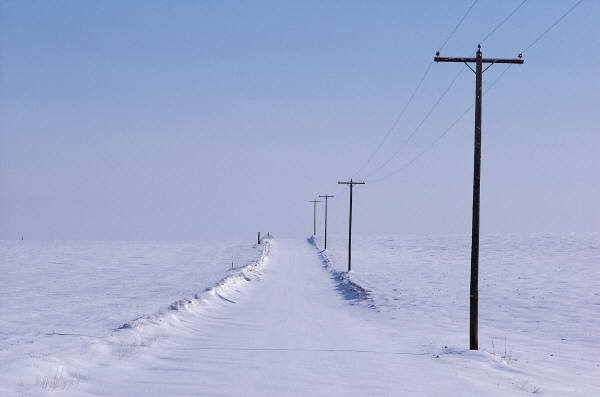
- Flurries - Light snow falling for short durations. No accumulation or light dusting is all that is expected.
- Showers - Snow falling at varying intensities for brief periods of time. Some accumulation is possible.
- Squalls - Brief, intense show showers accompanied by strong, gusty winds. Accumulation may be significant. Snow squalls are best known in the Great Lakes region.
- Blowing Snow - Wind-driven snow that reduces visibility and causes significant drifting. Blowing snow may be snow that is falling and/or loose snow on the ground picked up by the wind.
- Blizzard - Winds over 35 mph with snow and blowing snow reducing visibility to near zero.
Sleet
Is formed by raindrops that freeze into ice pellets before reaching the ground. Sleet usually bounces when hitting a surface and does not stick to objects. However, it can accumulate like snow and cause a hazard to motorists.
Freezing Rain
Is rain that falls onto a surface that has a temperature below freezing. This causes it to freeze to surfaces, such as trees, cars, and roads, forming a coating or glaze of ice. Even small accumulations of ice can cause a significant hazard.
Wind Chill
The wind chill is based on the rate of heat loss from exposed skin caused by combined effects of wind and cold. As the wind increases, heat is carried away from the body at an accelerated rate, driving down the body temperature. Animals are also affected by wind chill.
WINTER DRIVING
The leading cause of death during winter storms is transportation accidents. Preparing your vehicle for the winter season and knowing how to react if stranded or lost on the road are the keys to safe winter driving.
Have a mechanic check the following items on your car:
- Battery
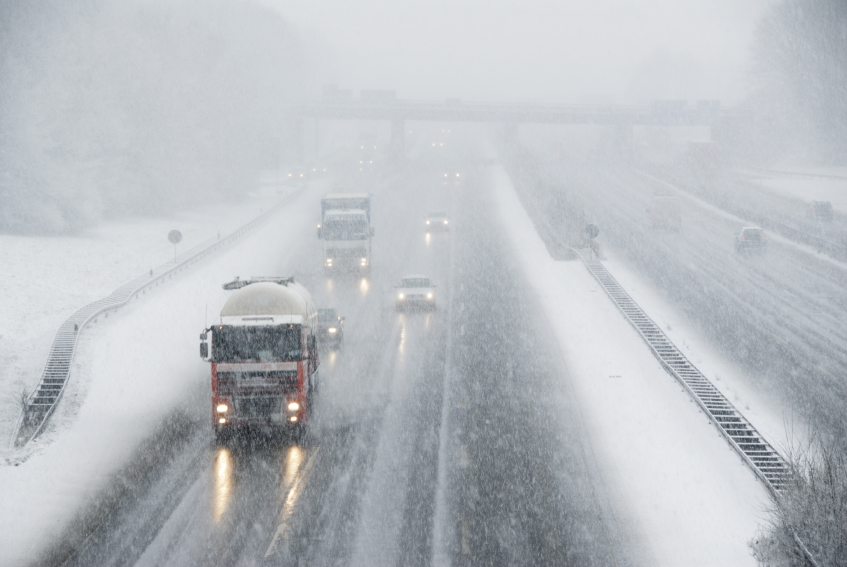
- Antifreeze
- Wipers and windshield washer fluid
- Ignition system
- Thermostat
- Lights
- Flashing hazard lights
- Exhaust system
- Heater
- Brakes
- Defroster
- Oil level (if necessary, replace existing oil with a winter grade oil or the SAE 10w/30 weight variety)
- Install good winter tires. Make sure the tires have adequate tread. All-weather radials are usually adequate for most winter conditions.
- Keep a windshield scraper and small broom for ice and snow
removal.
- Maintain at least a half tank of gas during the winter season.
- Plan long trips carefully. Listen to the radio or Call 511 from anywhere in Nebraska for Nebraska Traveler information for the latest road conditions. Always travel during daylight and, if possible, try not to travel alone.
- Let someone know your timetable and primary and alternate
routes.
- Dress to fit the season. Wear loose-fitting, light-weight, warm clothing in several layers. Trapped air insulates. Layers can be removed to avoid perspiration and subsequent chill. Outer garments should be tightly woven, water repellent and hooded. Wear a hat. Half your body heat loss can be from the head. Cover your mouth to protect your lungs from extreme cold. Mittens, snug at the wrist, are better than gloves. Try to stay dry.
- Carry food and water. Store a supply of high-energy "munchies" and several bottles of water.
Carry a WINTER STORM SURVIVAL KIT in your vehicle that includes:
- Flashlights with extra batteries
- First aid kit with pocket knife
- Necessary medications
- Several blankets
- Sleeping bags
- Extra newspapers for insulation
- Plastic bags (for sanitation)
- Matches
- Extra set of mittens, socks, and a wool cap
- Rain gear and extra clothes
- Small shovel
- Small sack of sand for generating traction under wheels
- Small tools (pliers, wrench, screwdriver)
- Booster cables
- Set of tire chains or traction mats
- Cards, games, and puzzles
- Brightly colored cloth for a flag
- Canned fruit and nuts
- Non-electric can opener
- Bottled water
IF TRAPPED IN CAR DURING A BLIZZARD:
- Stay in the car. Do not leave the car to search for assistance unless help is visible within 100 yards. You may become disoriented and lost in blowing and drifting snow.
- Display a trouble sign. Hang a brightly colored cloth on the radio antenna and raise the car hood.
- Occasionally run engine to keep warm. Turn on the car's engine for about 10 minutes each hour. Run the heater when the car is running. Also, turn on the car's dome light when the car is running. Beware of carbon monoxide poisoning. Keep the exhaust pipe clear of snow and open a downwind
window slightly for ventilation.
- Watch for signs of frostbite and hypothermia.
- Do minor exercises to keep up circulation. Clap hands and move arms and legs occasionally. Try not to stay in one position for too long.
- If more than one person is in the car, take turns sleeping.
- For warmth, huddle together. Use newspapers, maps, and even the removable car mats for added insulation.
- Avoid overexertion. Cold weather puts an added strain on the heart. Unaccustomed exercise such as shoveling snow or pushing a car can bring on a heart attack or make other medical conditions worse. Be aware of symptoms of dehydration.
County Benefits
The Buffalo County Veterans Service Office offers the following benefits for those veterans who are eligible:
County Veterans Aid Fund
The CVA fund is a temporary emergency fund to assist veterans, their spouses, and dependents when there is an unforeseen emergency and there are no other resources available. Eligible veterans are persons who served on active duty, received an Honorable Discharge, and served during one of the defined "wartime eras" and who have resided in Nebraska for at least one year, and Buffalo County for at least six months. Applicants may request assistance with food, shelter, clothing, funeral, medical, dental, and surgical items. The applicant must apply through the County Service Office in Buffalo County. This is an "aid" program so the veteran must demonstrate an "inability" to meet the obligation to pay these bills, via an application.
Bronze Grave Flag Holders
State of Nebraska statute requires the County Veterans Service Office to provide a flag holder reflecting the veterans wartime era. The Buffalo County, Veterans Service Office also annually inventories these flag holders to insure they remains on the correct grave and we replace damaged markers.
Registration of DD214s
Buffalo County records a "certified copy" of the original copy of a veterans military separation document (DD-214). Once recorded the veteran may call us from any where in the world and we will provide them with a "certified copy" when needed.
Homestead Exemption
Annually, the Buffalo County Veterans Service Office obtains a letter from the VA Regional Office that establishes who are eligible veterans (or widows) for a tax exemption on their personal residence. These letters are provided to the County Assessor.
Grave Registration
Upon notification of the burial of a veteran in Buffalo County we complete a "grave registration card". We maintain a copy here in Buffalo County, and the original is sent to the State of Nebraska, Department of Veteran's Affairs in Lincoln. We also order a "Presidential Memorial Certificate" for the family of all deceased Buffalo County veterans.
Highway
 View on map View on map
There are approximately 962
square miles in Buffalo
County. Within this area there are 1500 miles of
road: 112.3 miles are County oil or concrete roads. There are 342 bridges over 20 feet in the
County. There are also 242 bridges that
are 20 feet and under which are not considered bridges but are classified as
culverts because of the constricted water flow.

There are 41 full time employees
and during the summer months we employ three to four more people. In addition to the Highway Superintendent,
there are: one assistant Highway Superintendent, two clerical, two foremen, 19
maintainer operators, five heavy equipment operators, one sign man, one welder,
two mechanics, one mechanic assistant and eight truck driver/operators.
We also have a large inventory of
machines and equipment valued at $9,143,598.00. This includes 21 maintainers, one crane, three backhoes, four loaders, 43
pickups and trucks and a considerable number of other pieces of equipment.
We have an excellent
communication system which includes 2-way radios which are used extensively. They save many miles of driving and enable
people to communicate from one corner of the county to the other. They have saved many maintainer men from
having to walk for help after having a flat tire, being stuck in a snowstorm or
any other emergency type situation. Our
foremen also have cellular phones.
We have 2-way radios in all the
maintainers, office, loaders and in a majority of our other equipment. The radios also give us communication with
the Sheriff’s Department an the County
Surveyor. The telephone system gives us easier
communication with the Sheriff’s Department, Surveyor, other County Courthouse
offices and also the City of Kearney
offices by dialing just four digits.
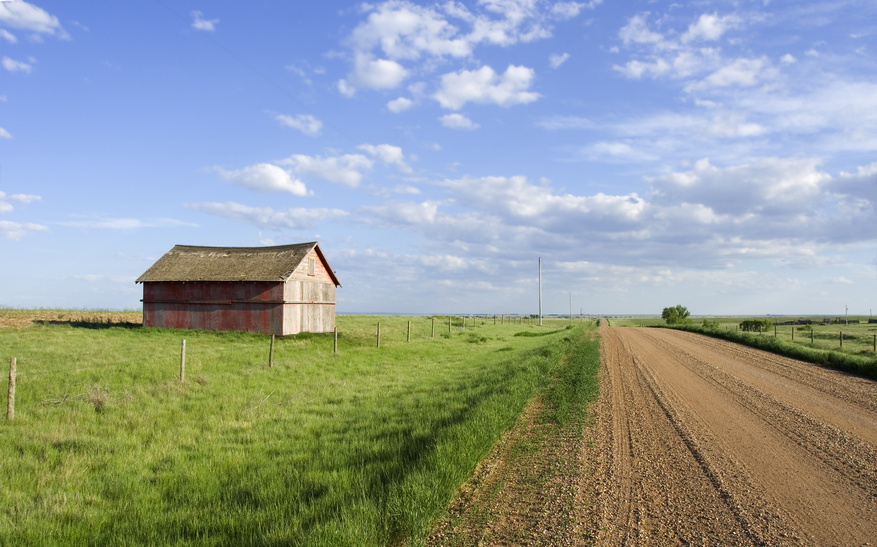
Buffalo County is divided into 26
Townships. We have divided the townships
into Zones 1 through 26. We bid gravel
once a year. The bid period is from
April 1 of one year to March 31 of the following year.
Buffalo County went to the GEO Base Addressing System and signs were installed in 1997. This system makes finding a resident faster in an emergency type situation.
|